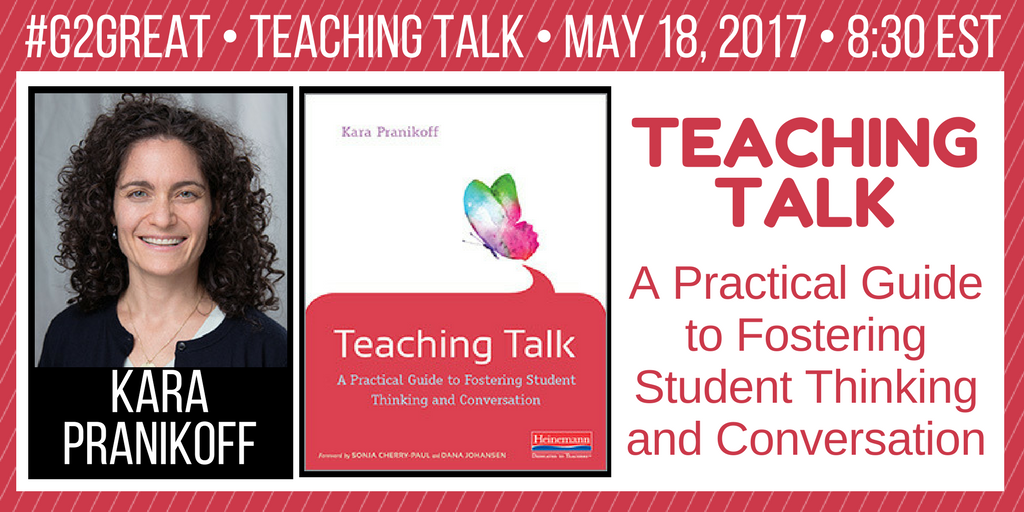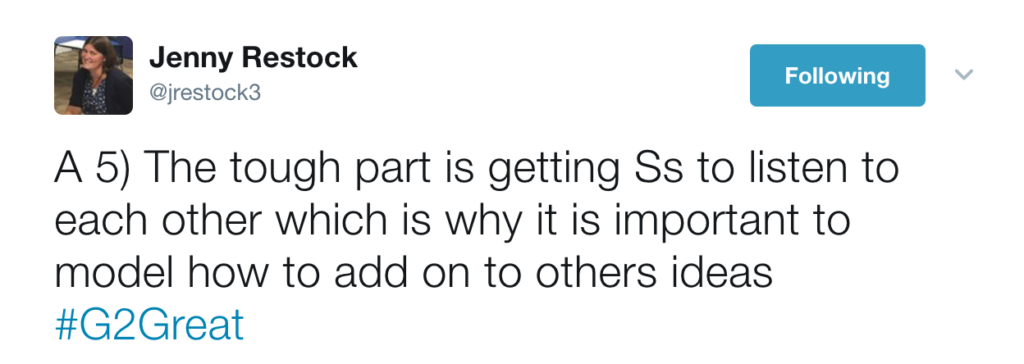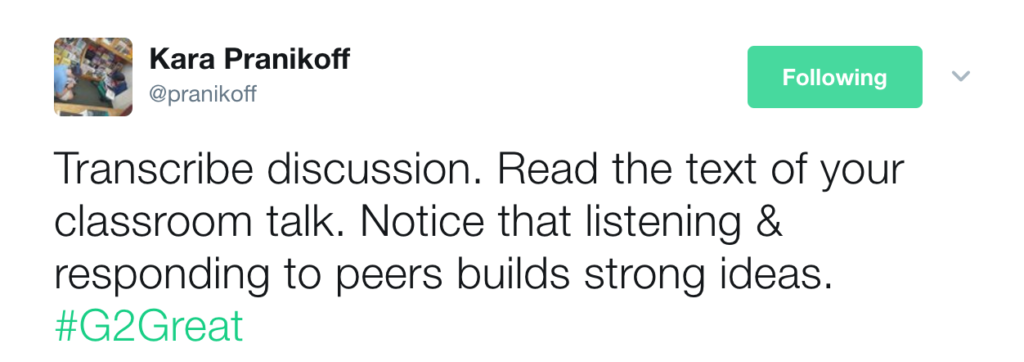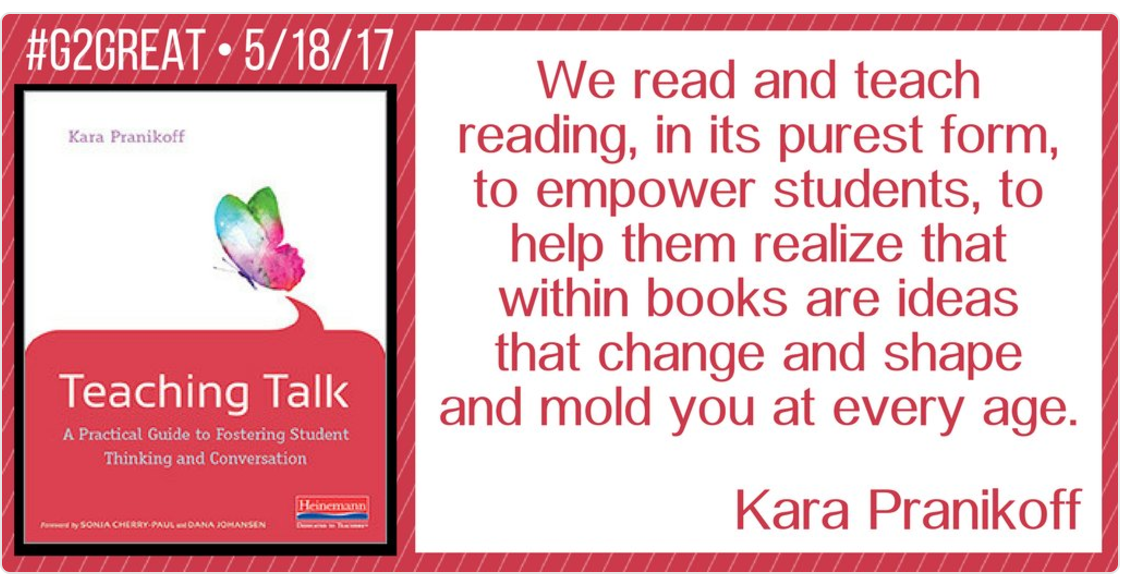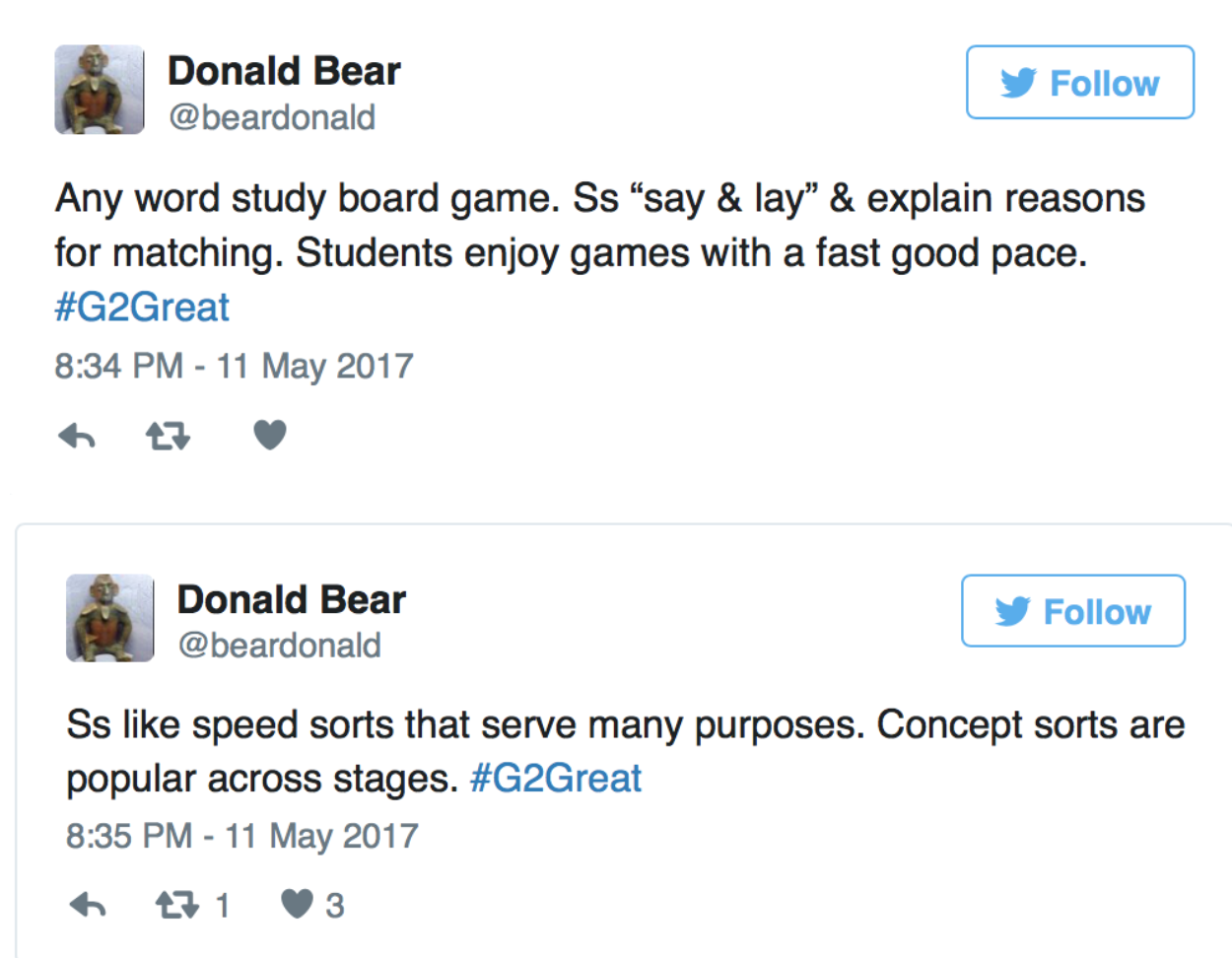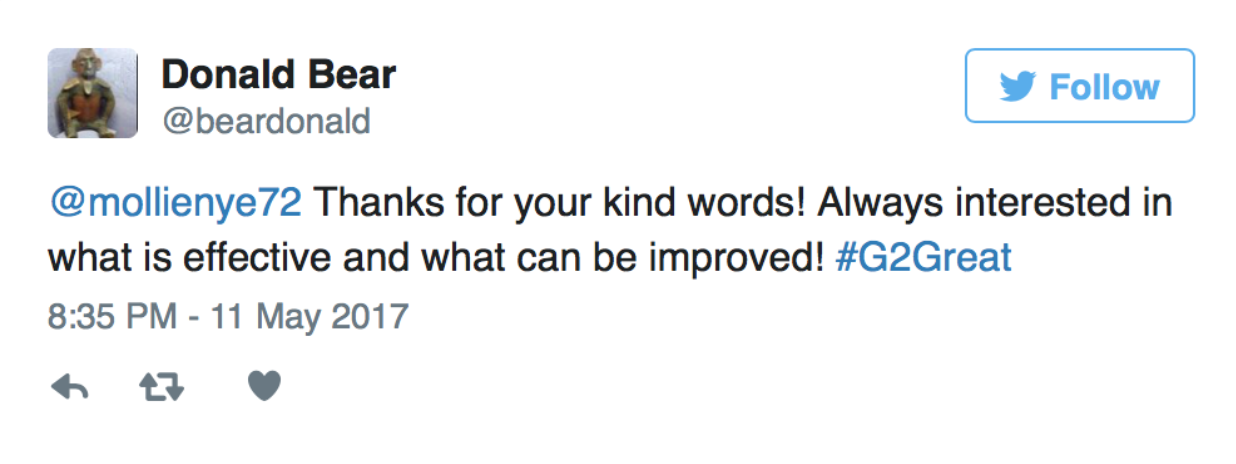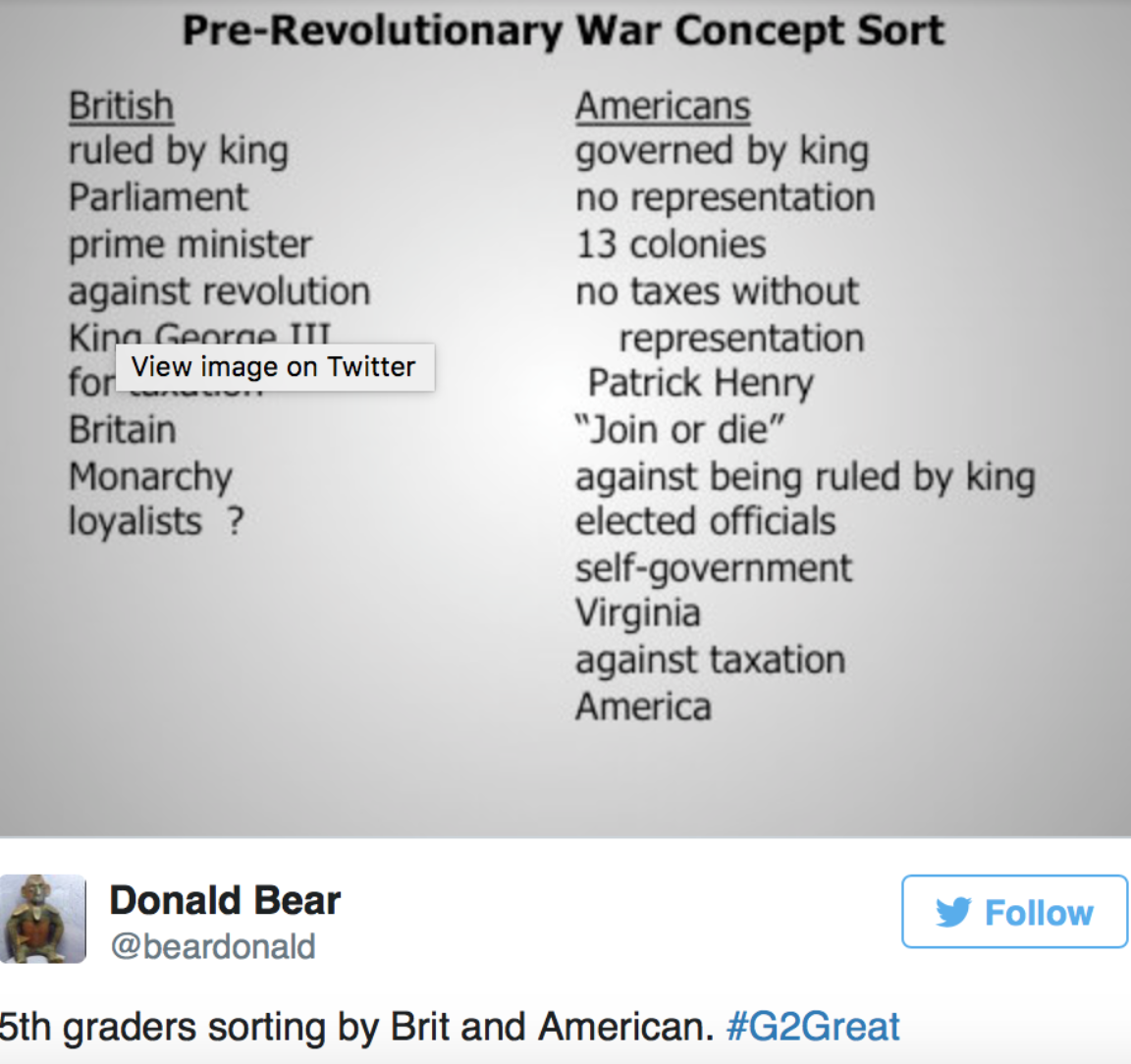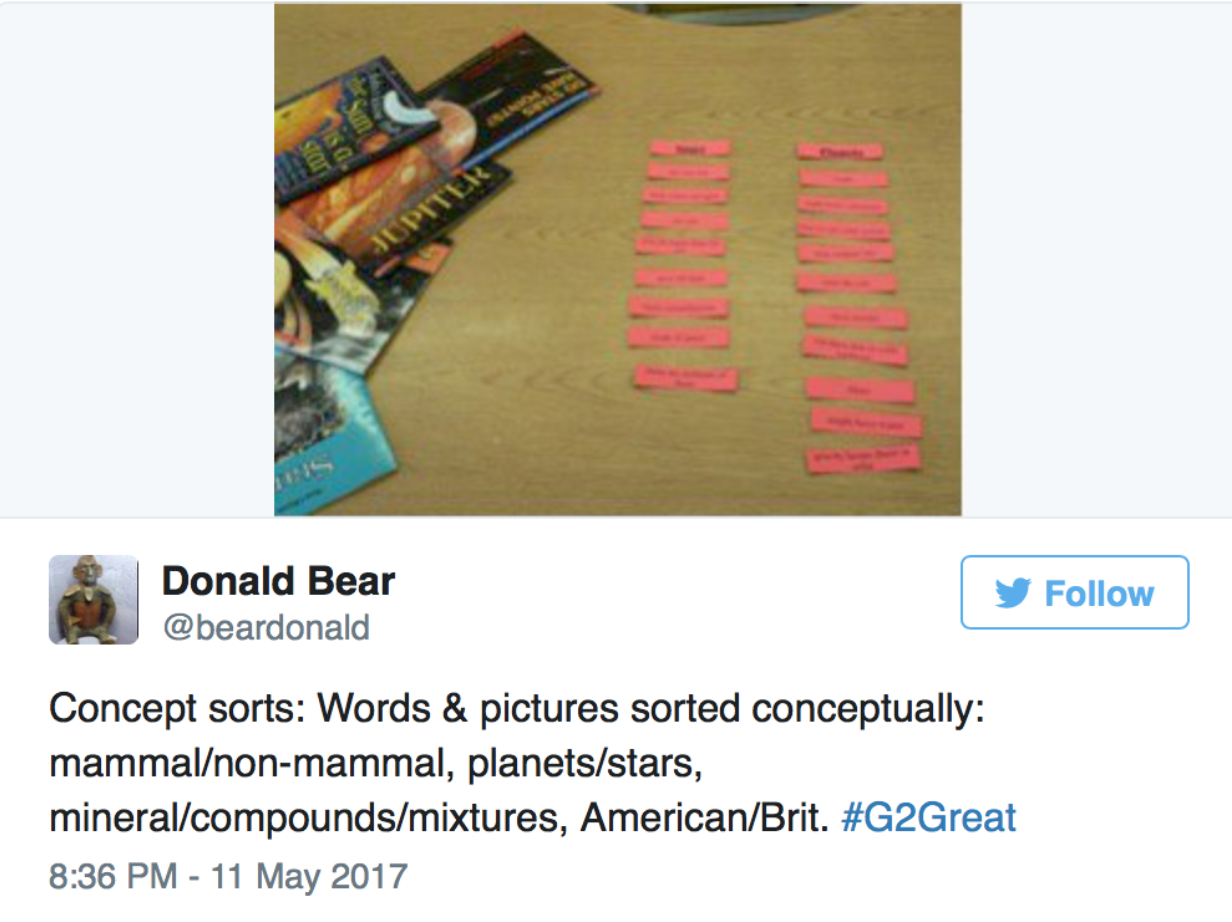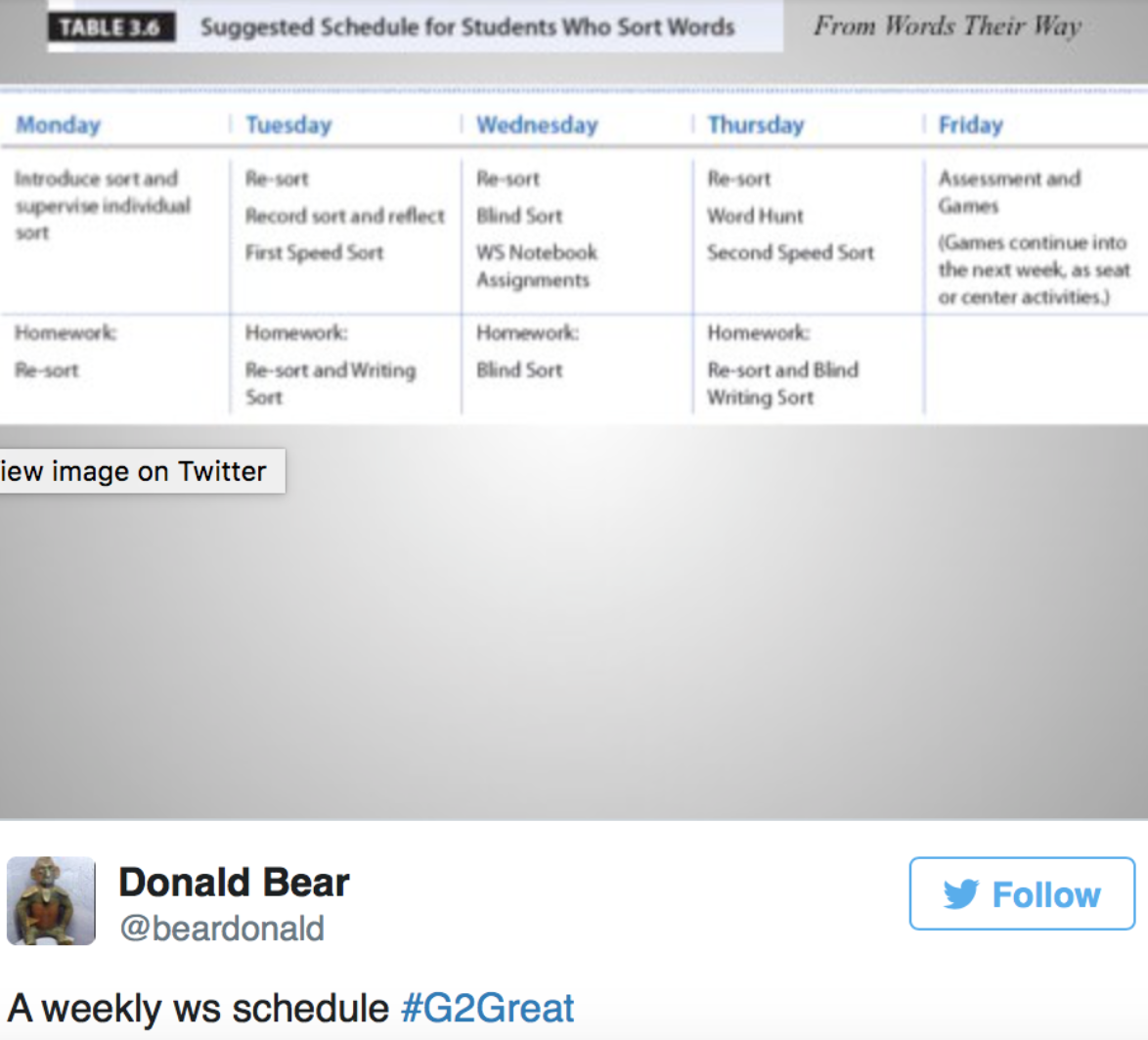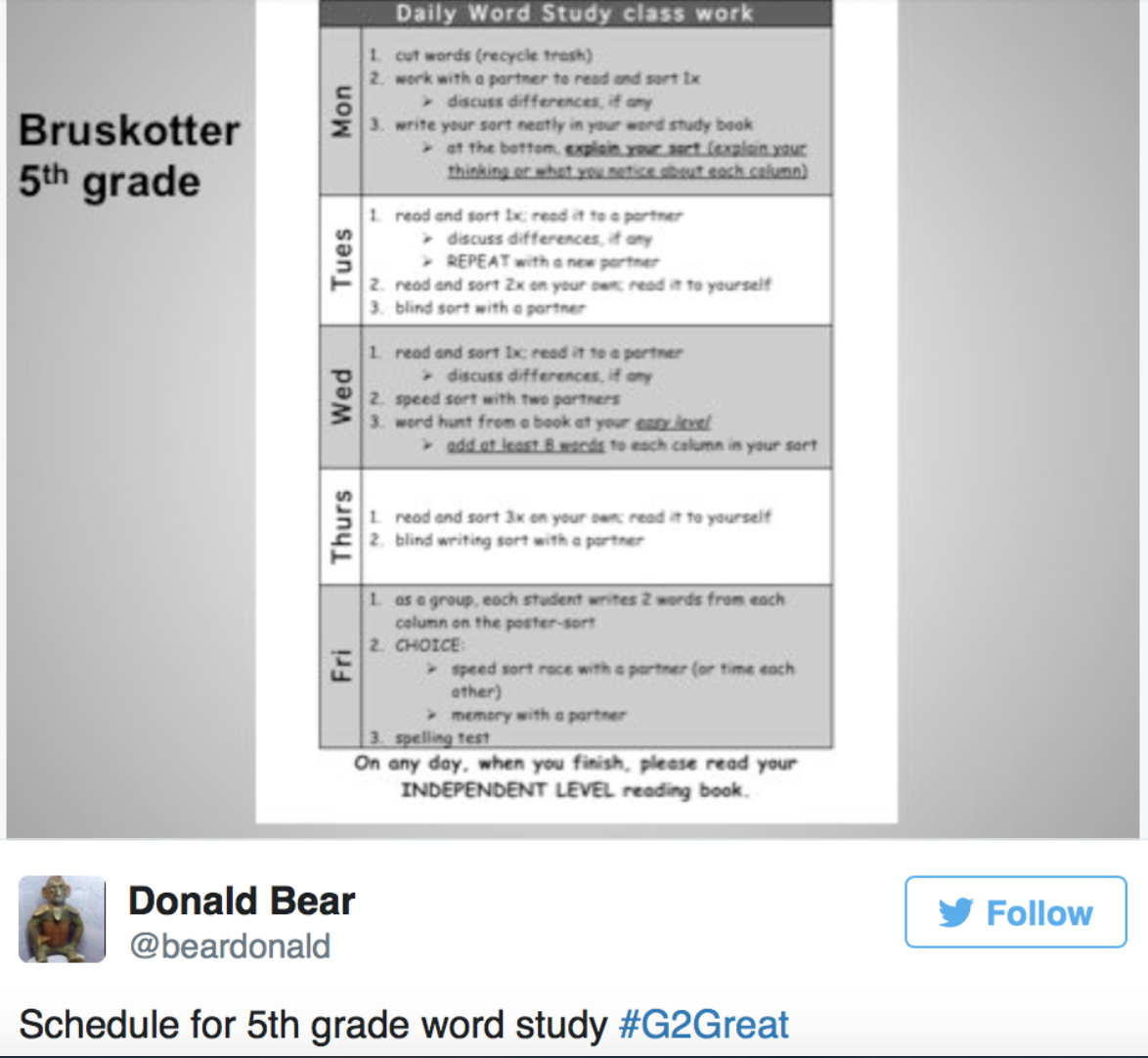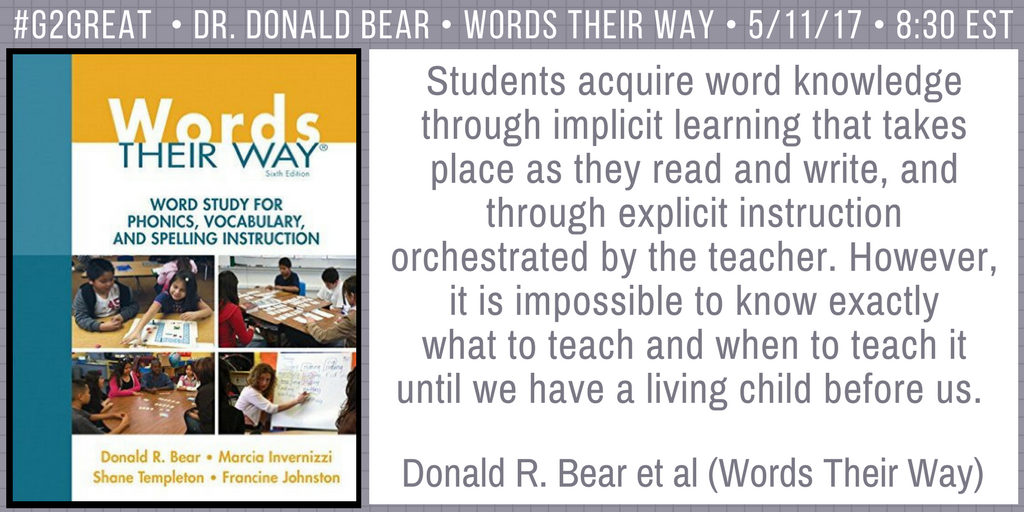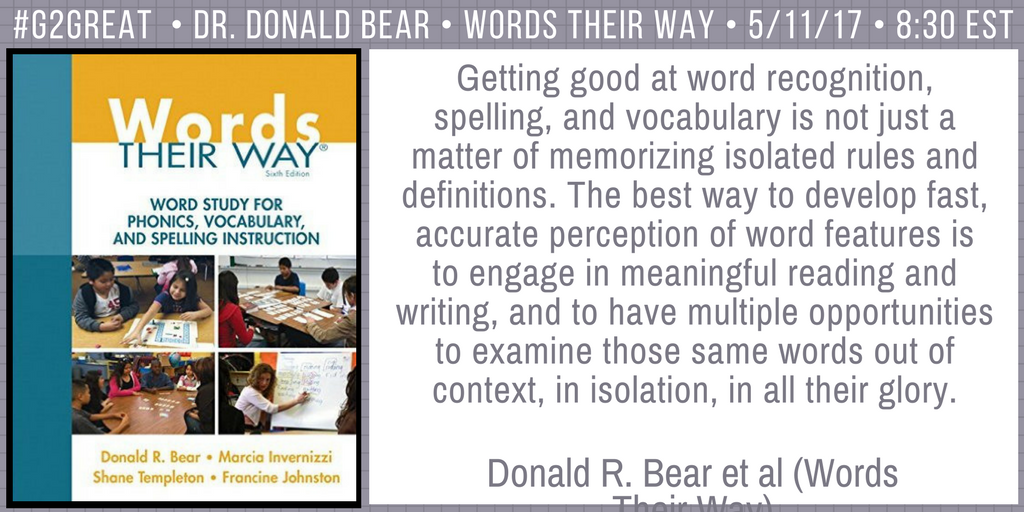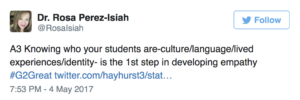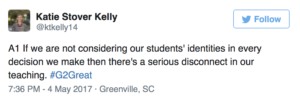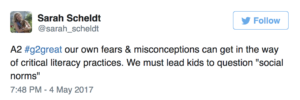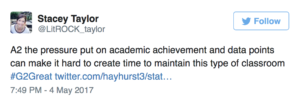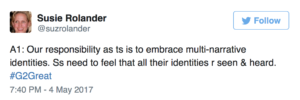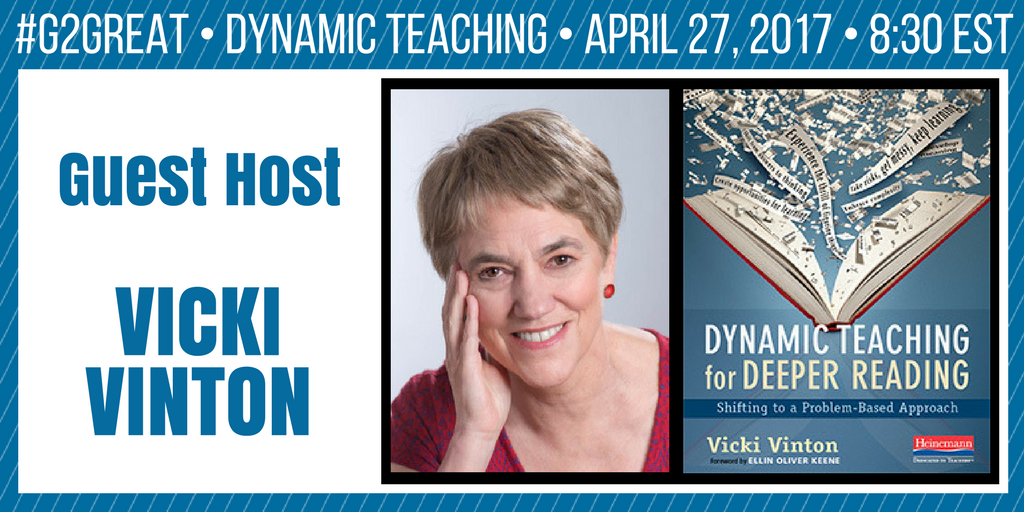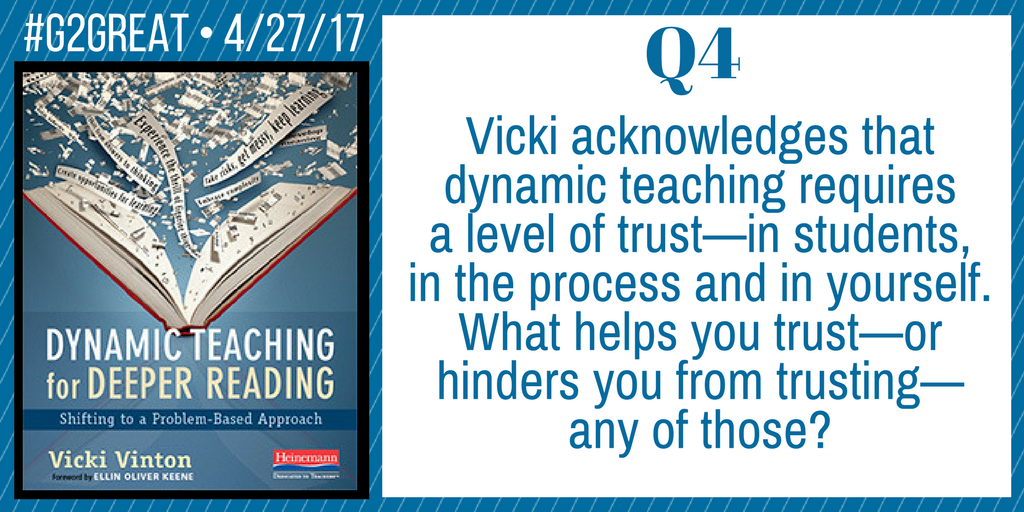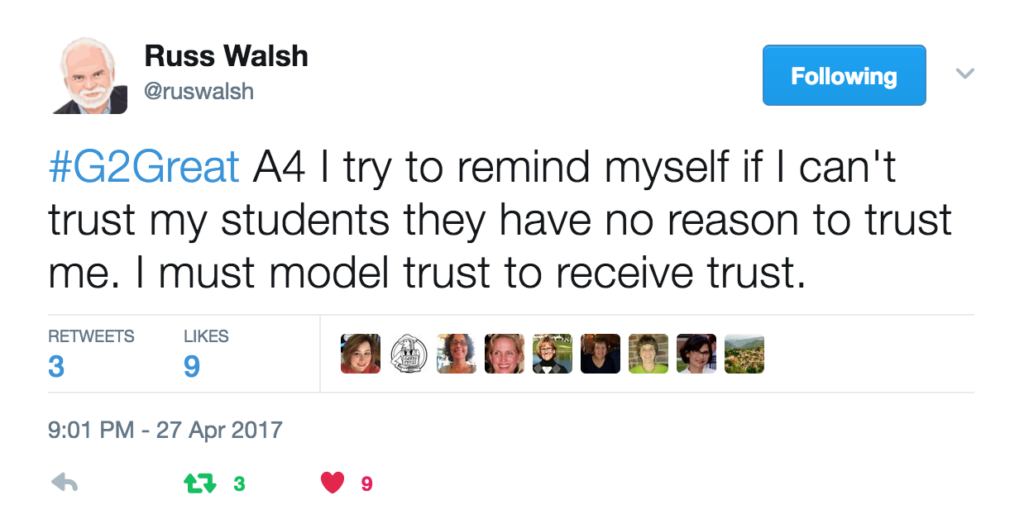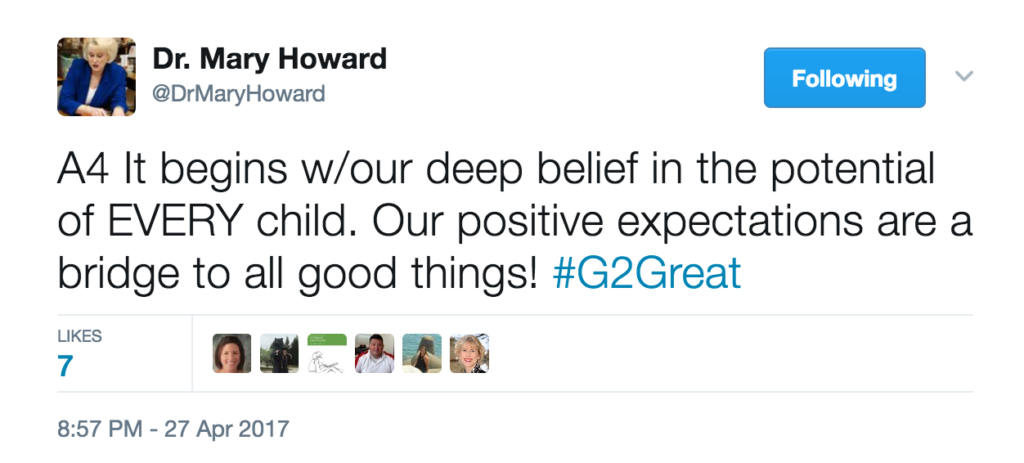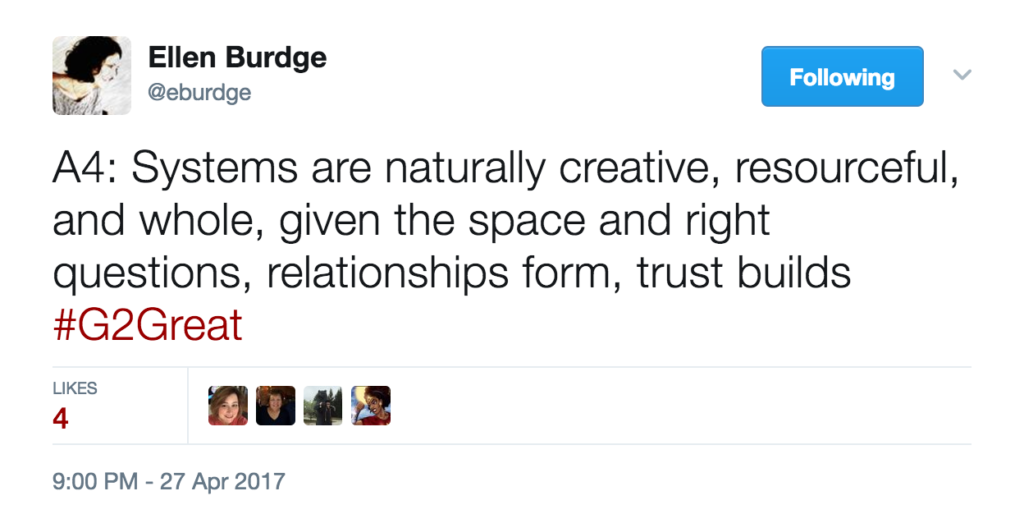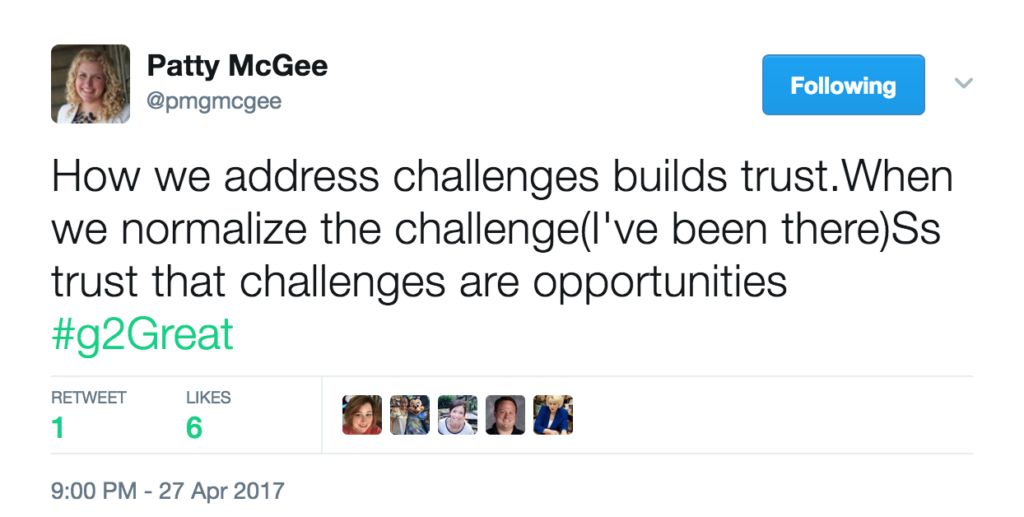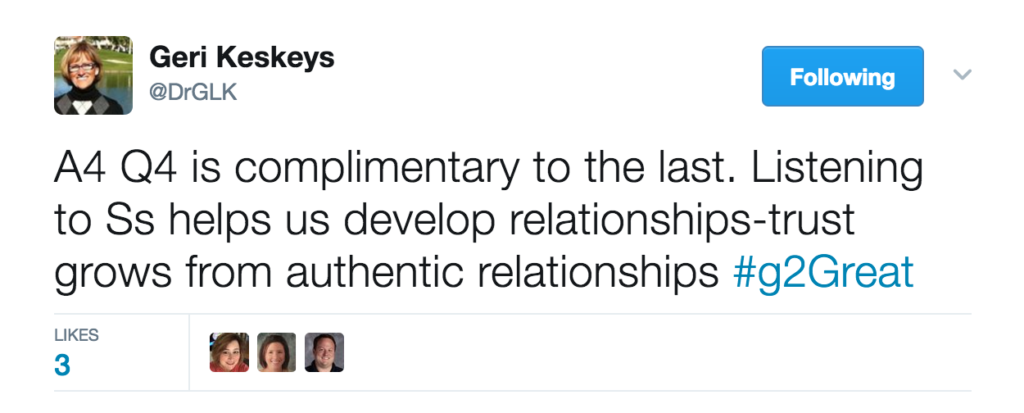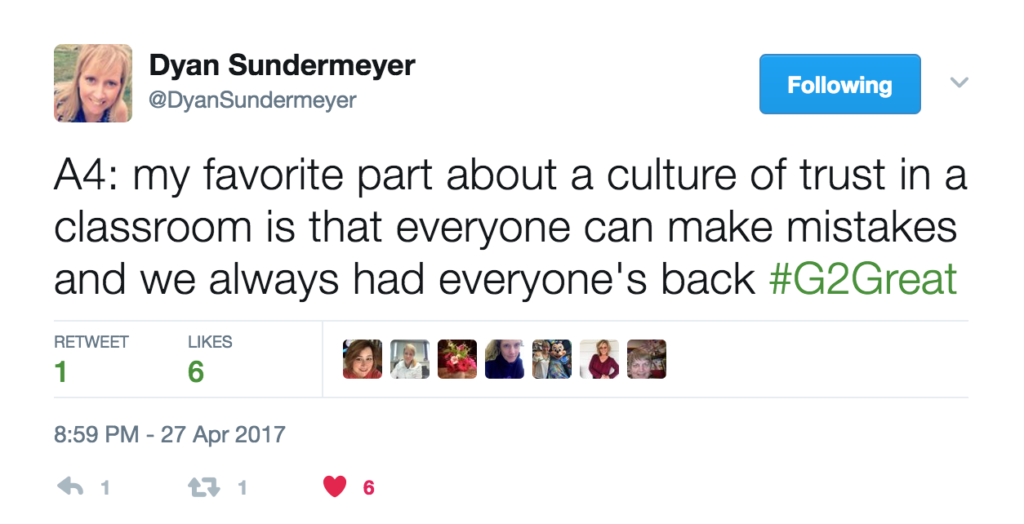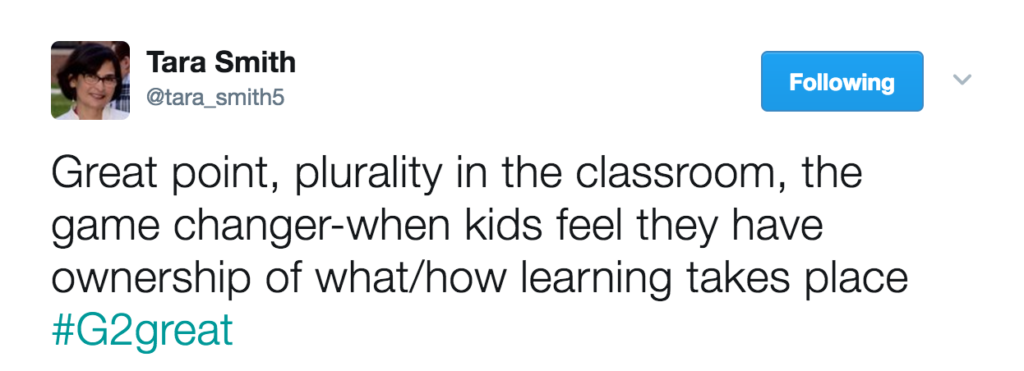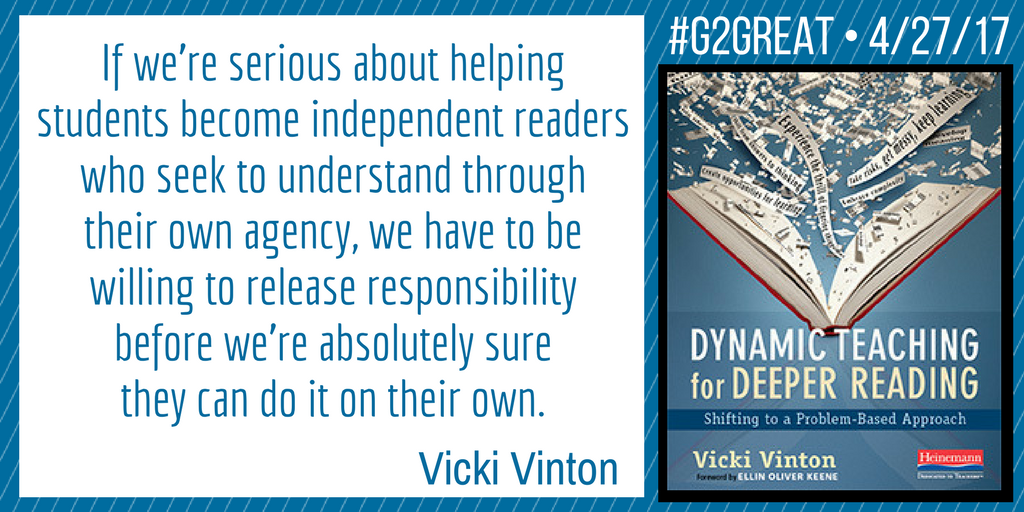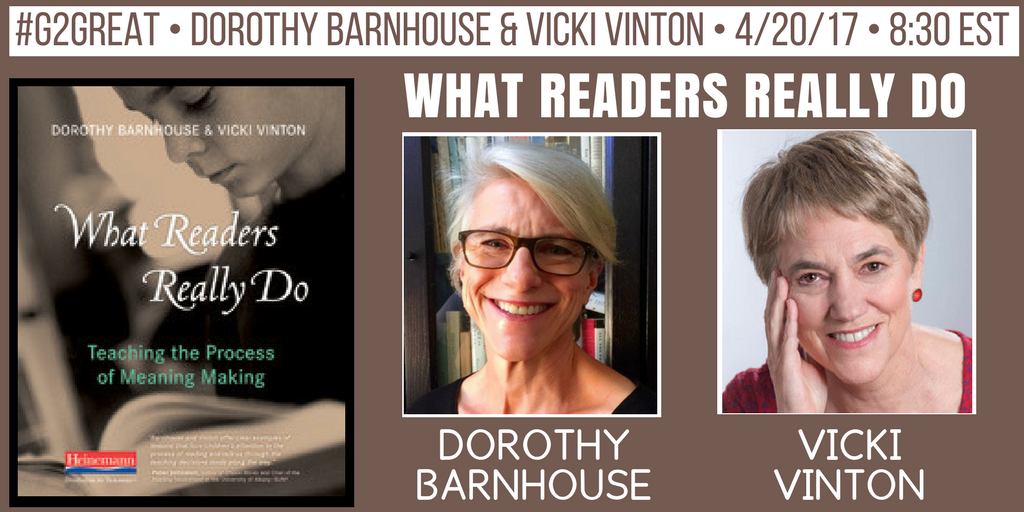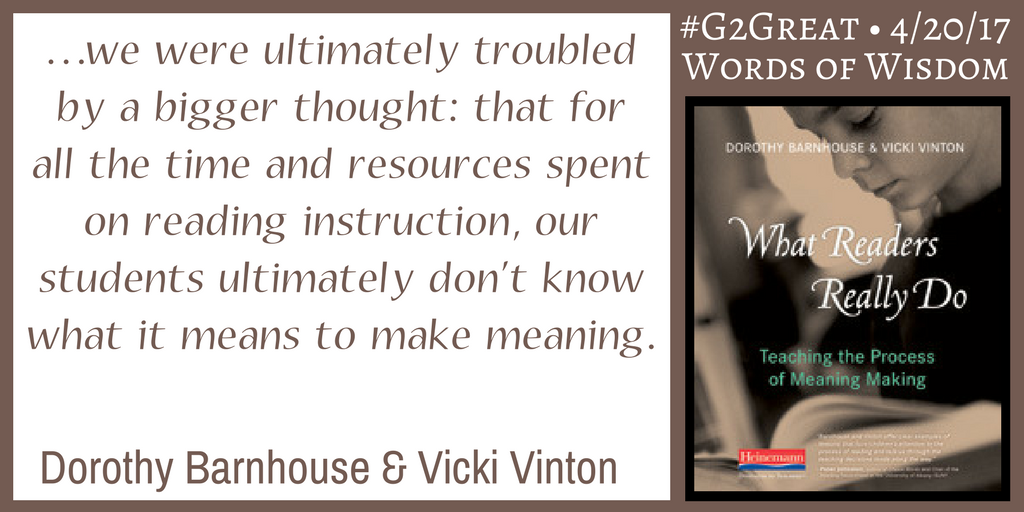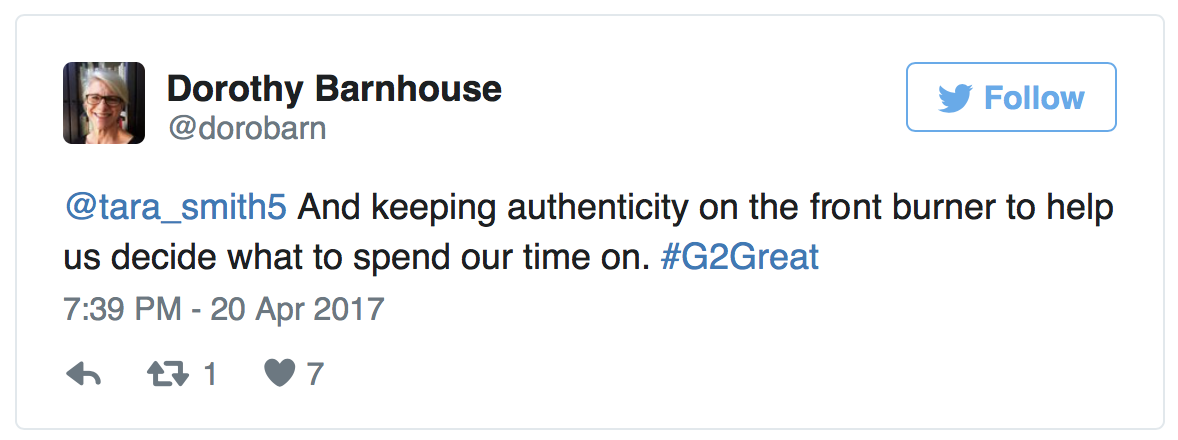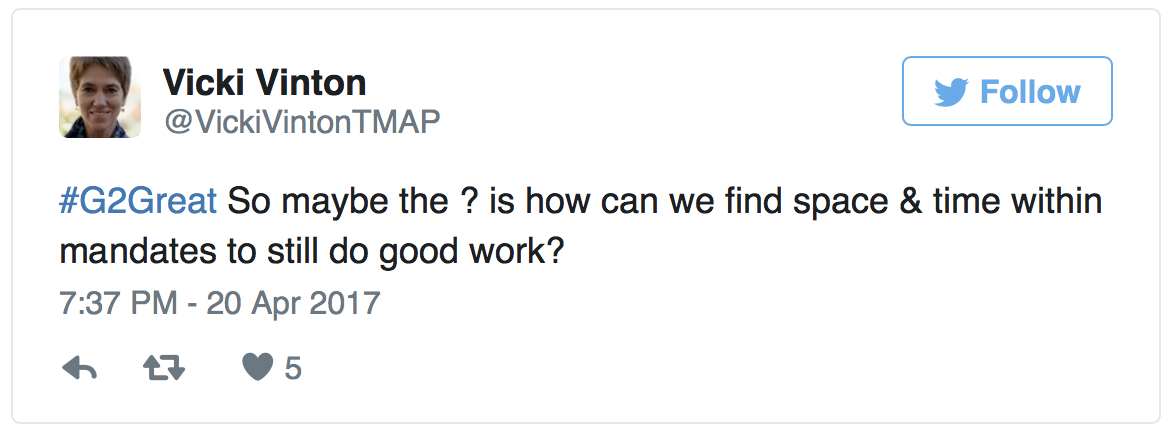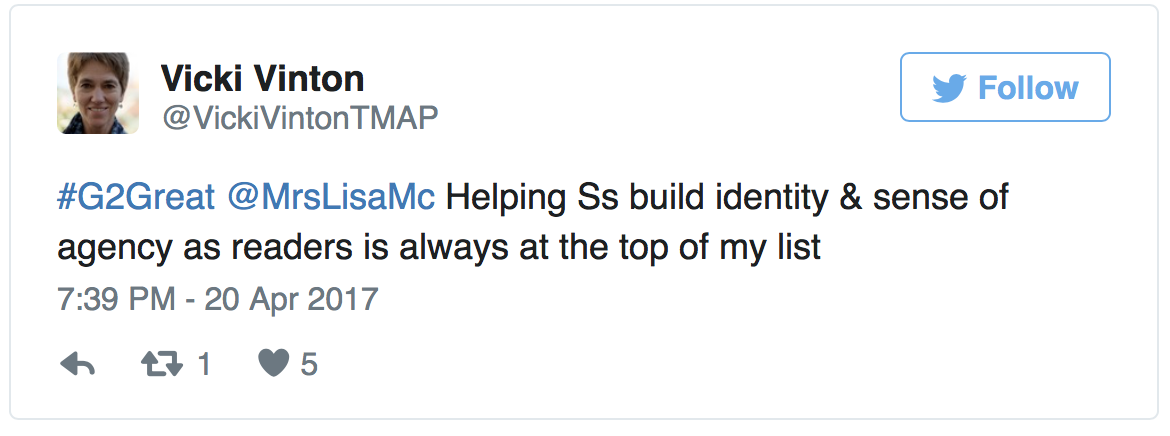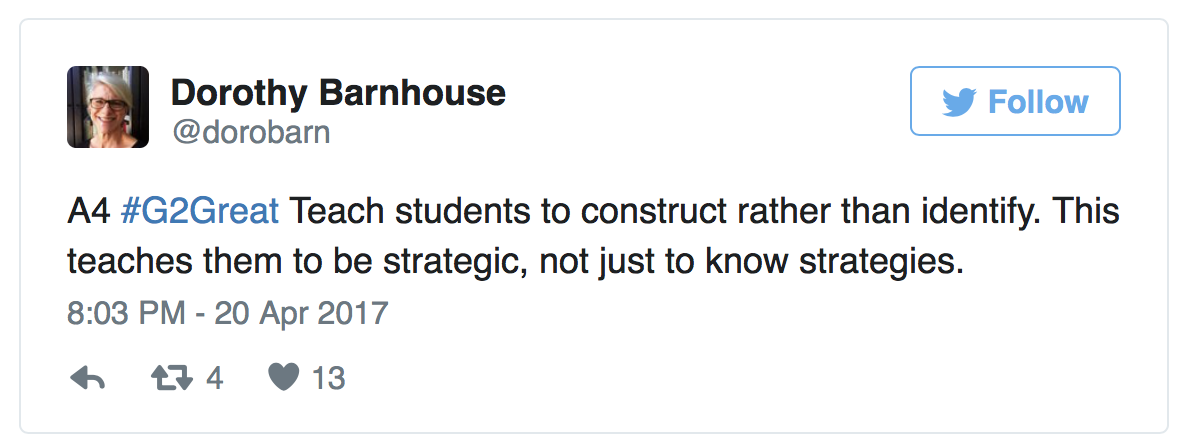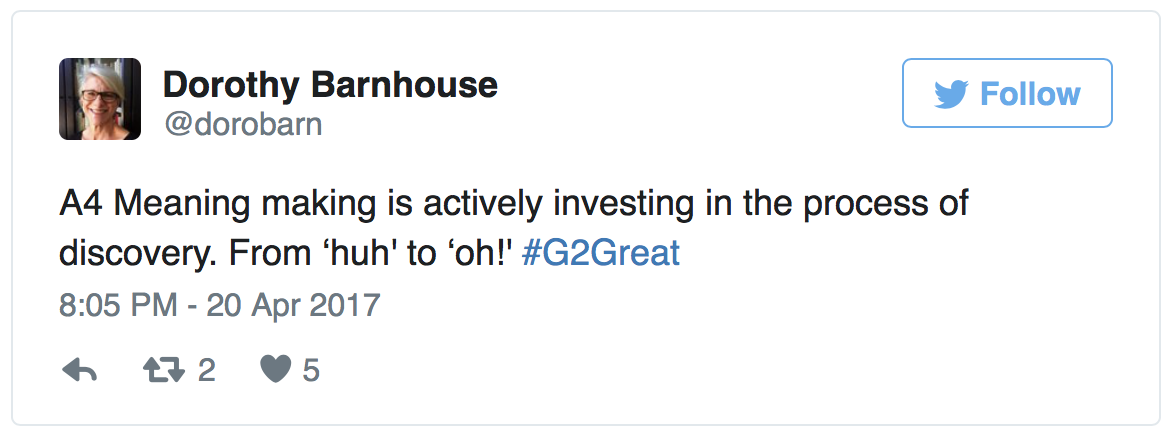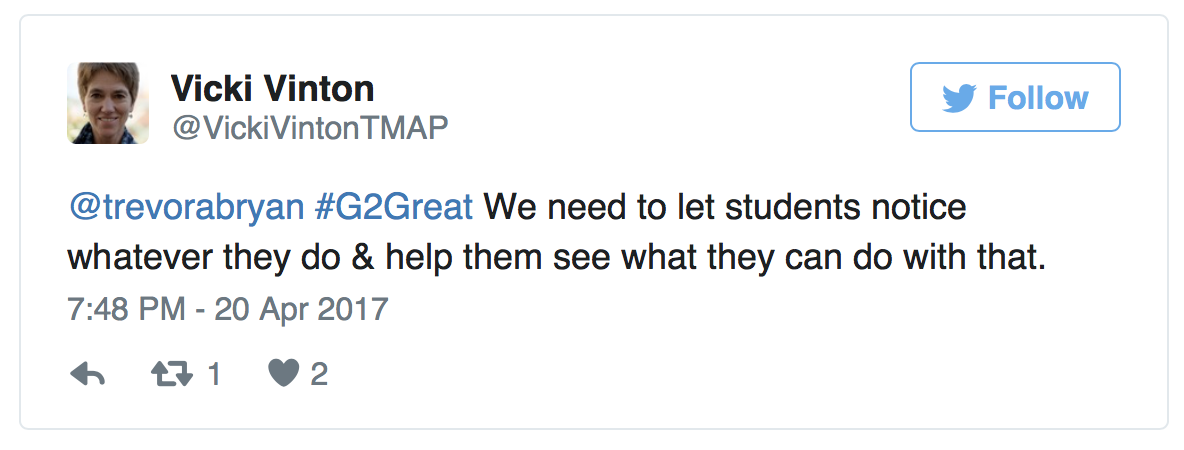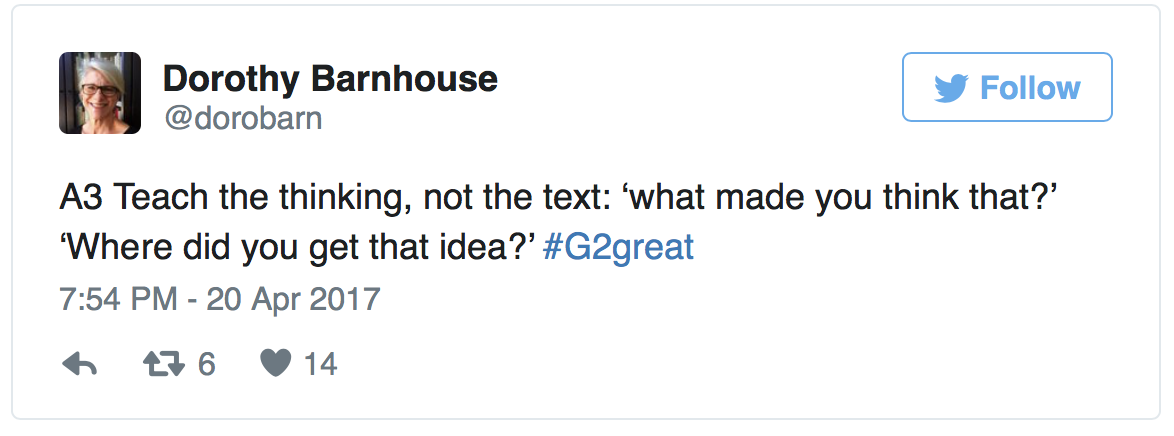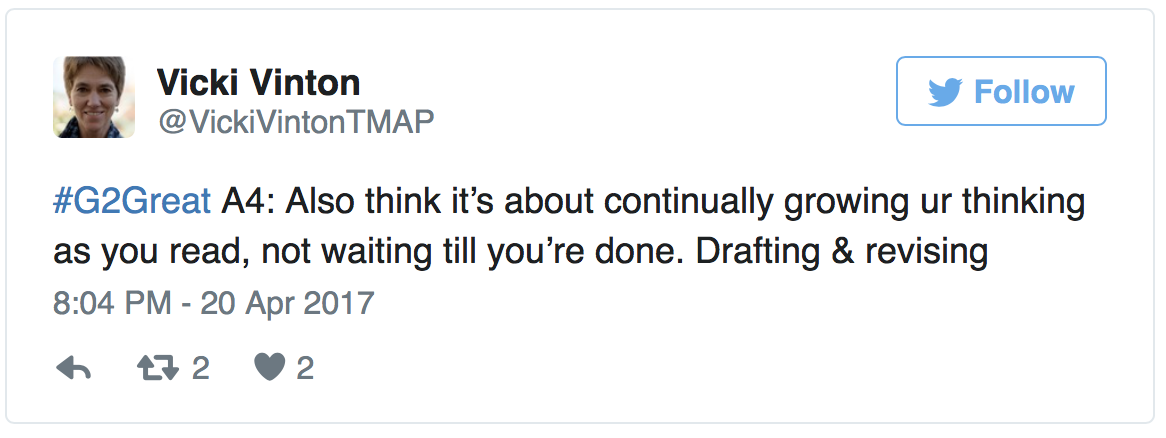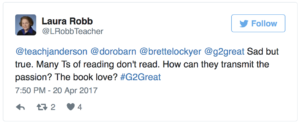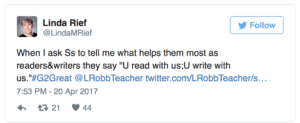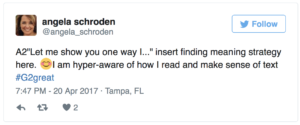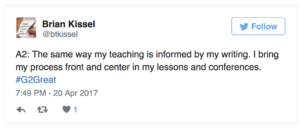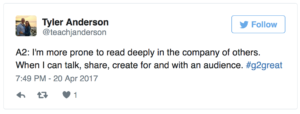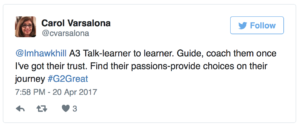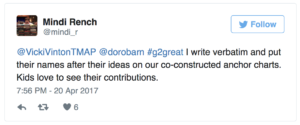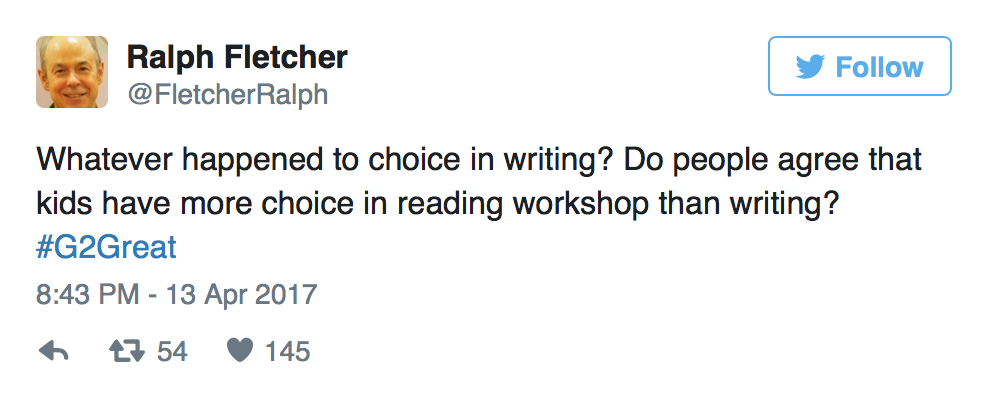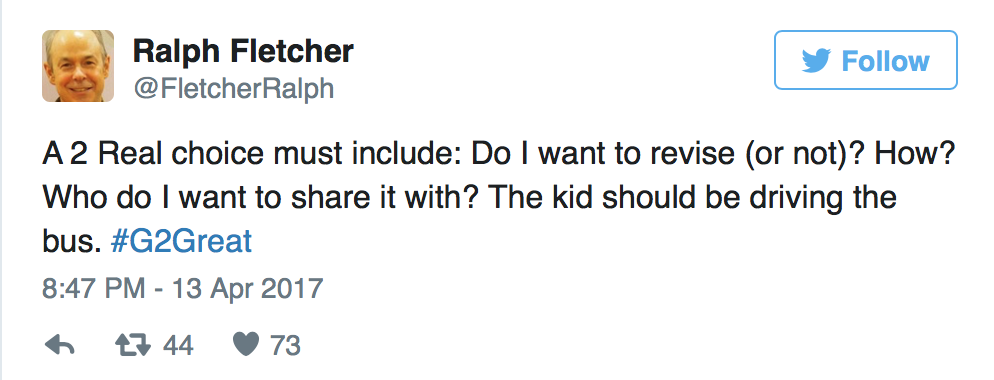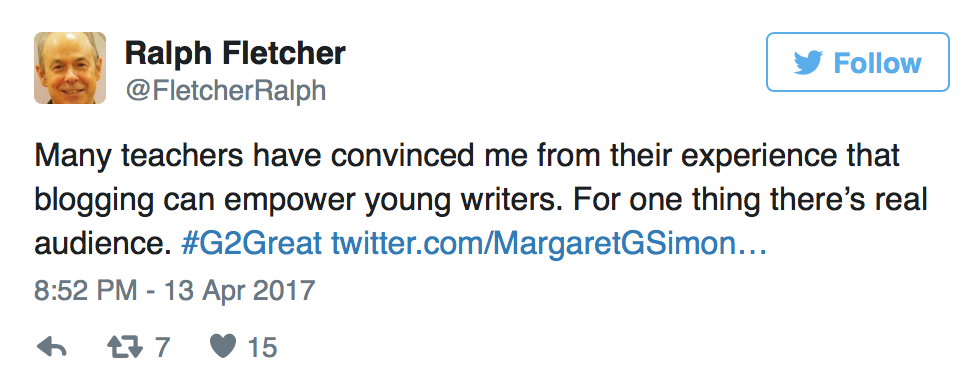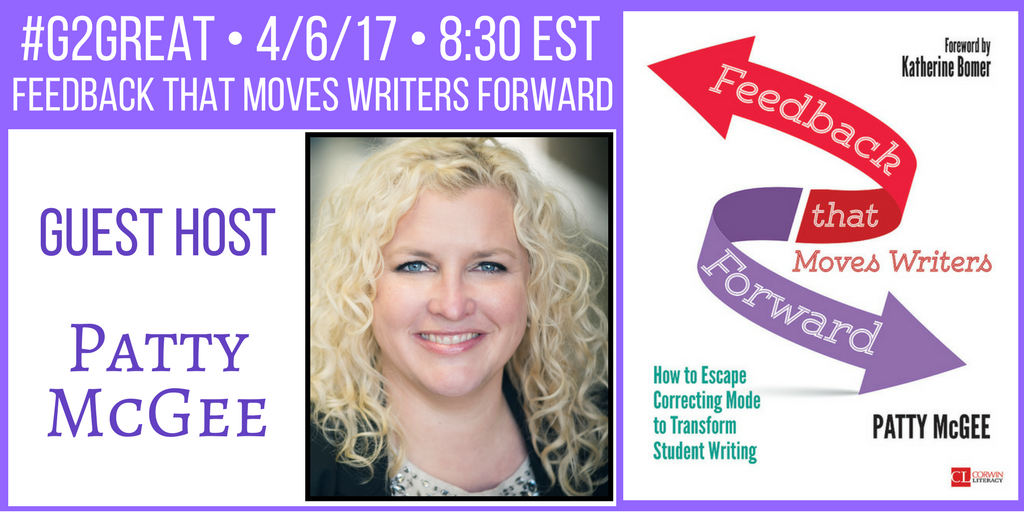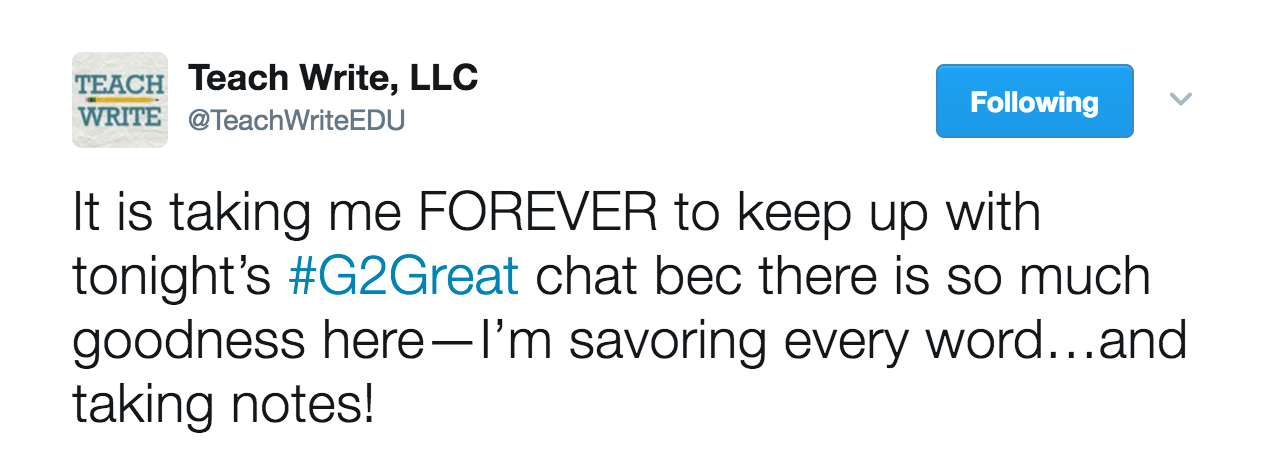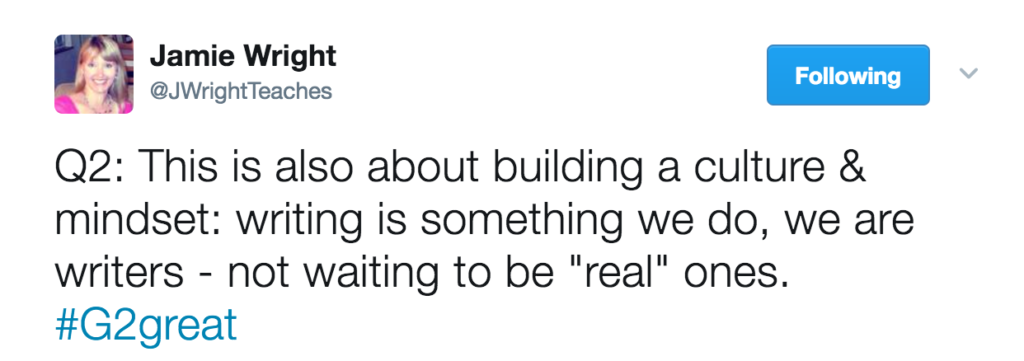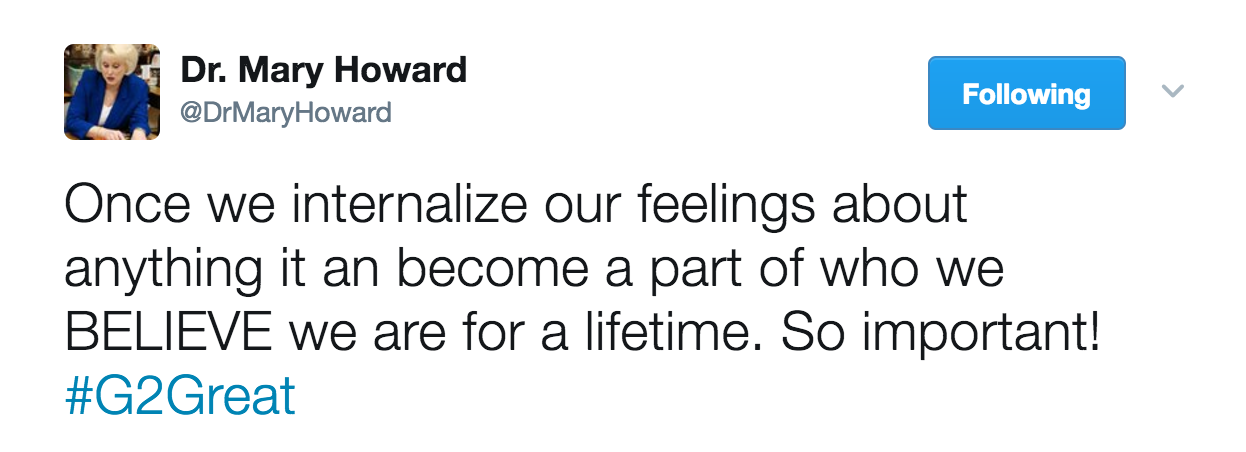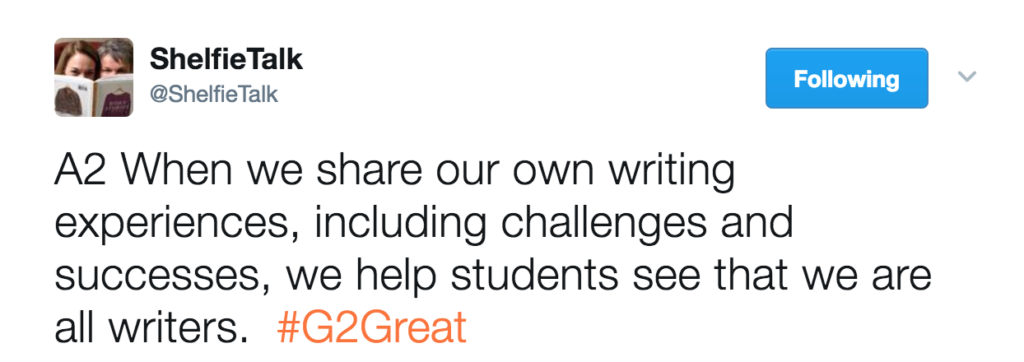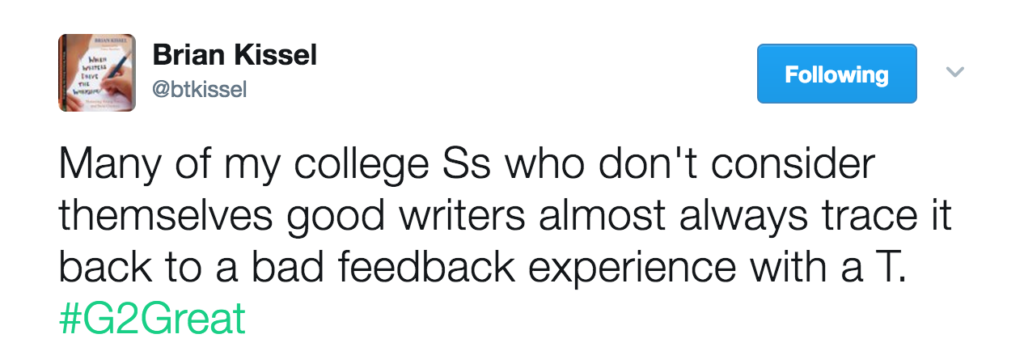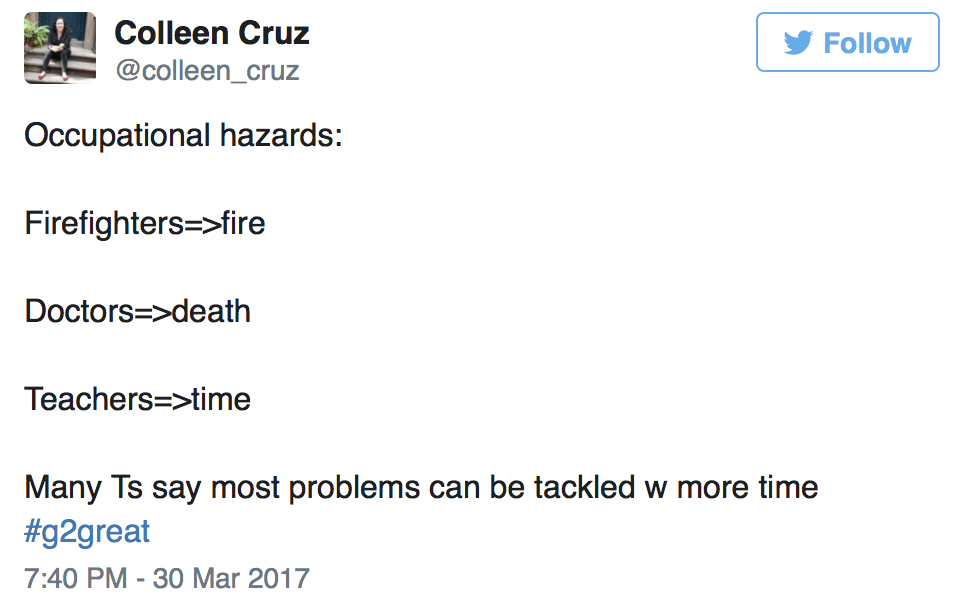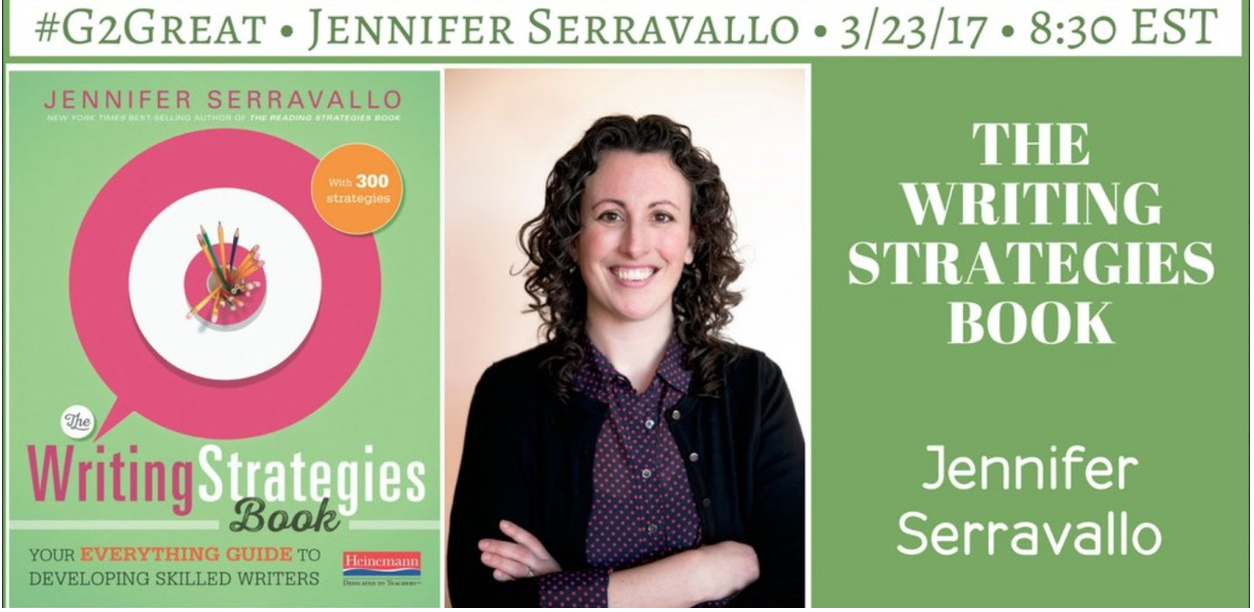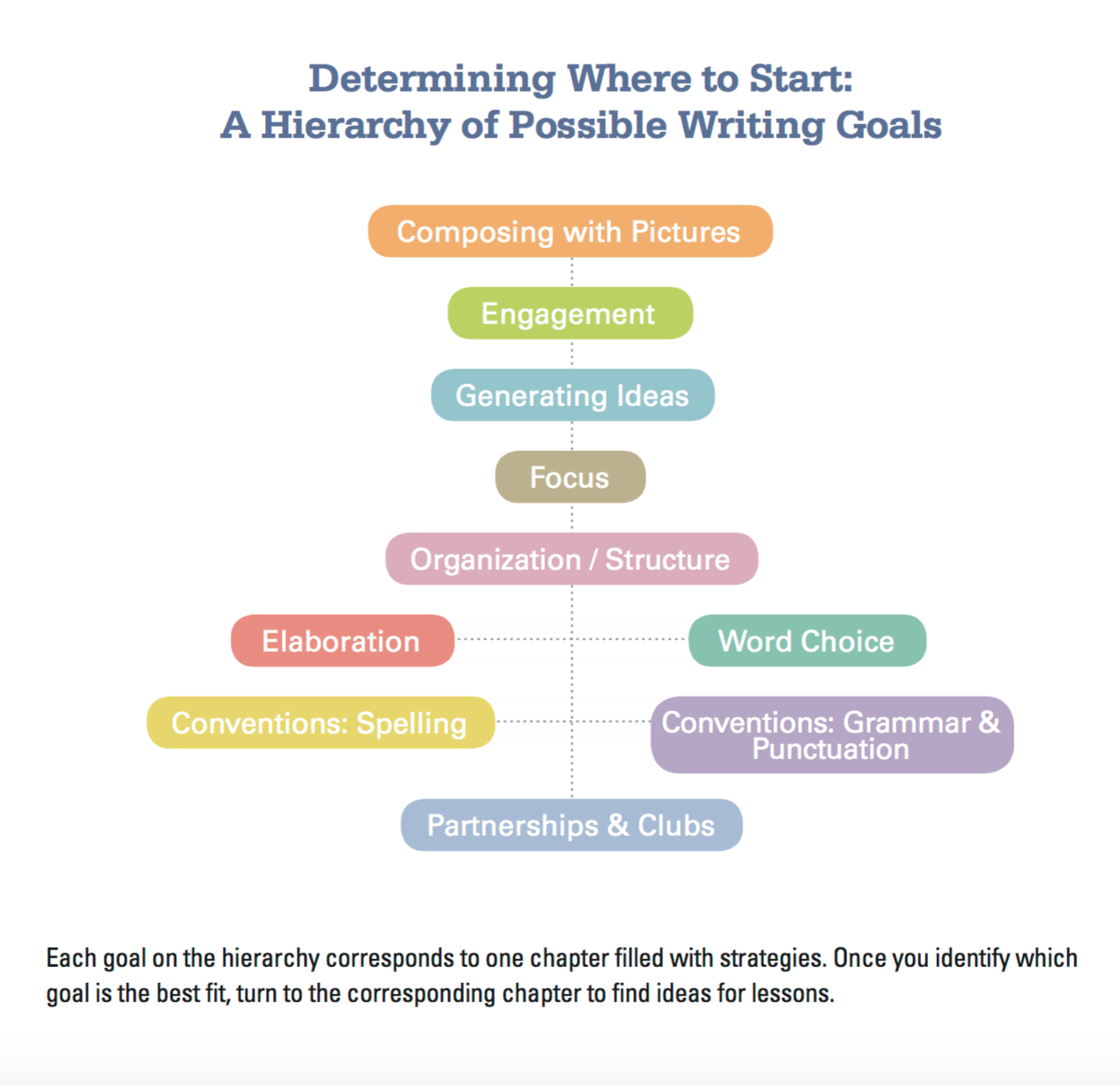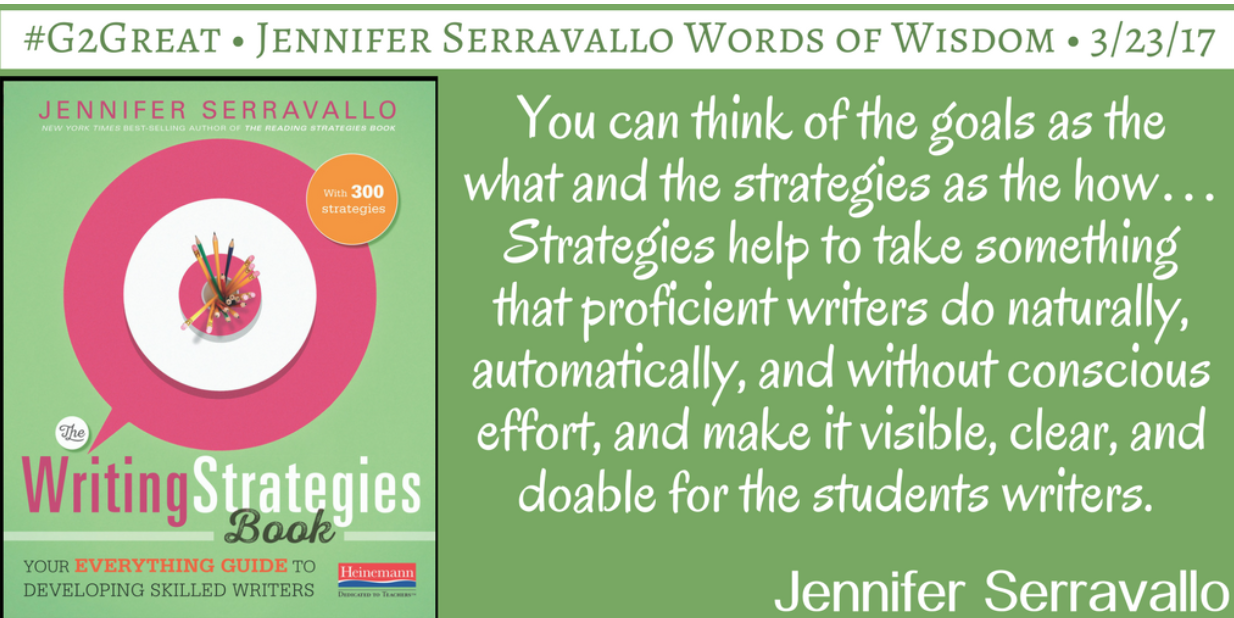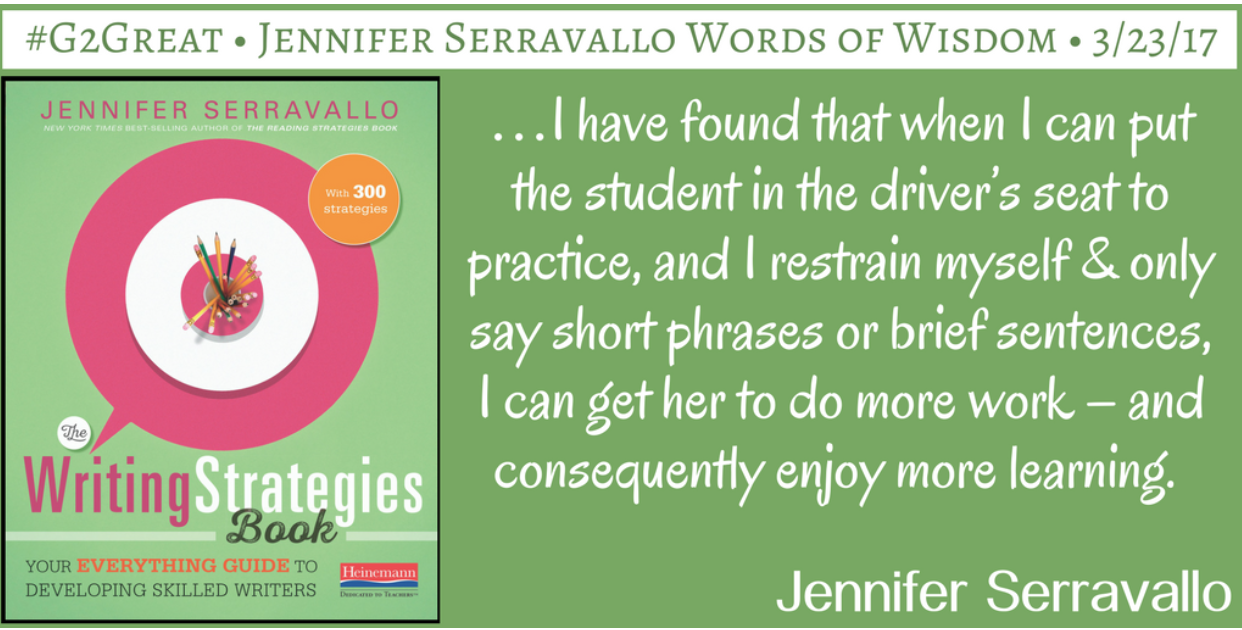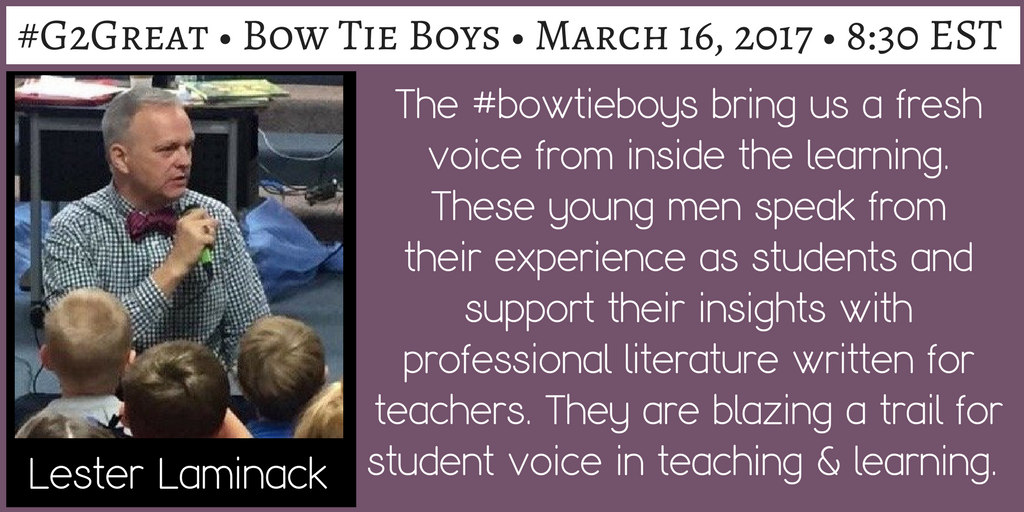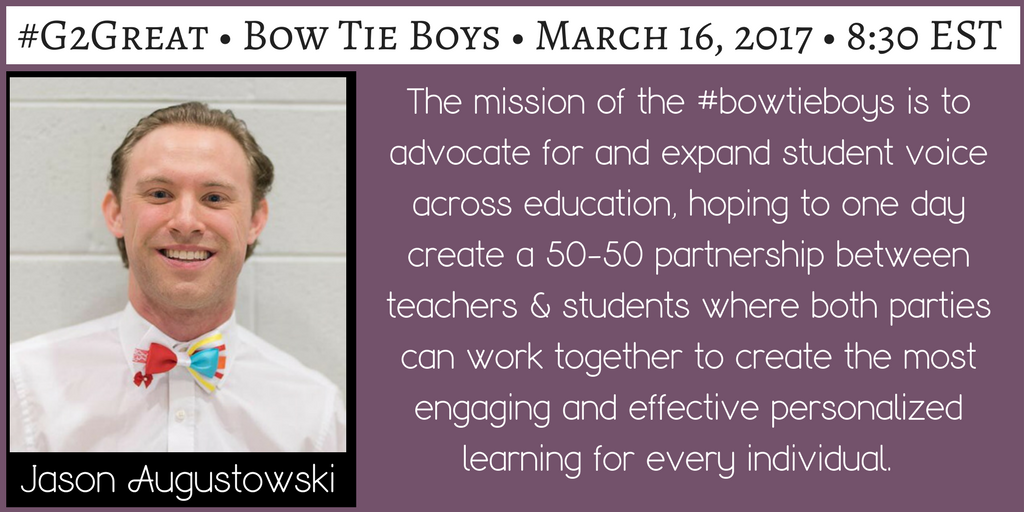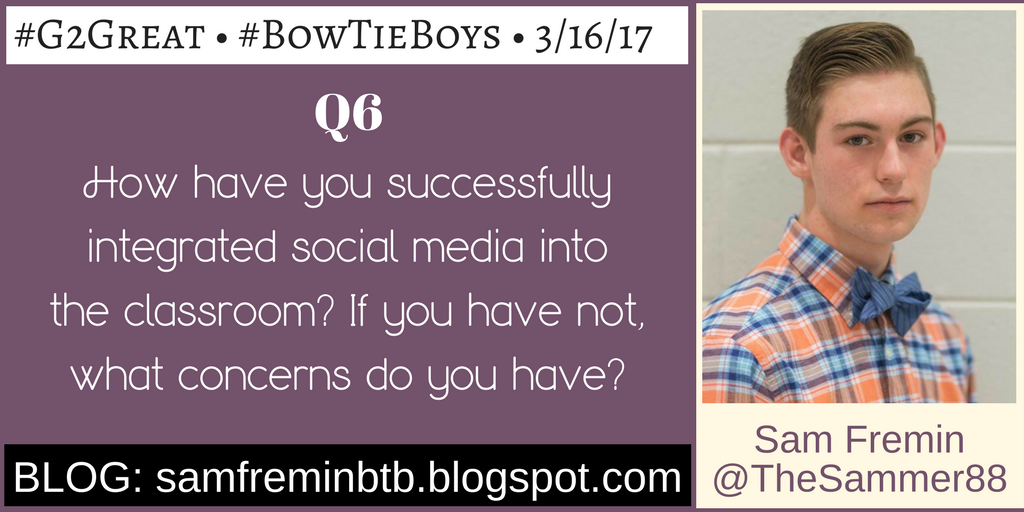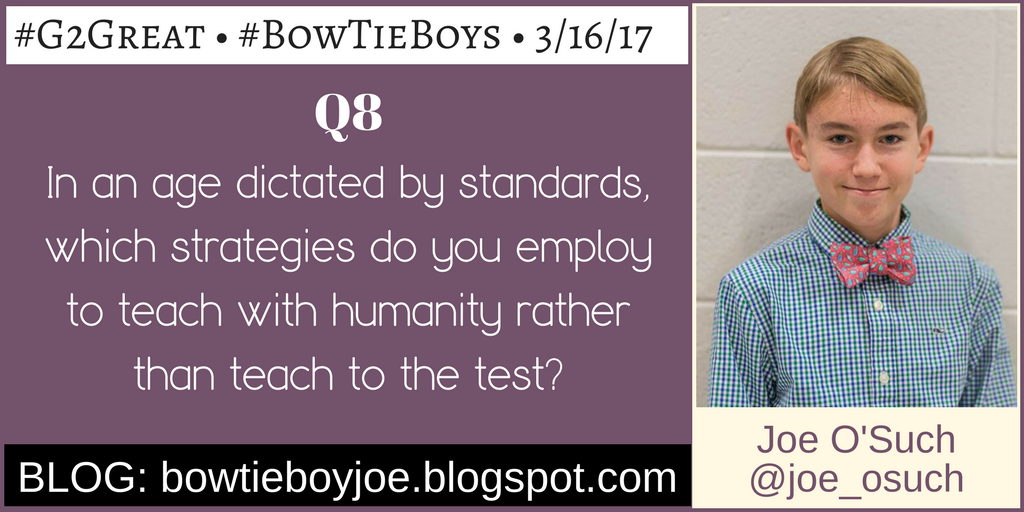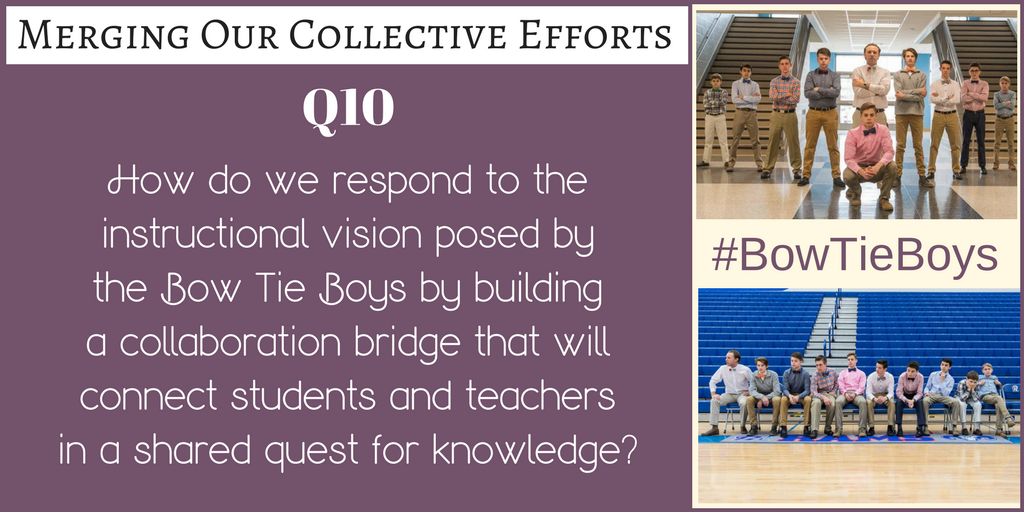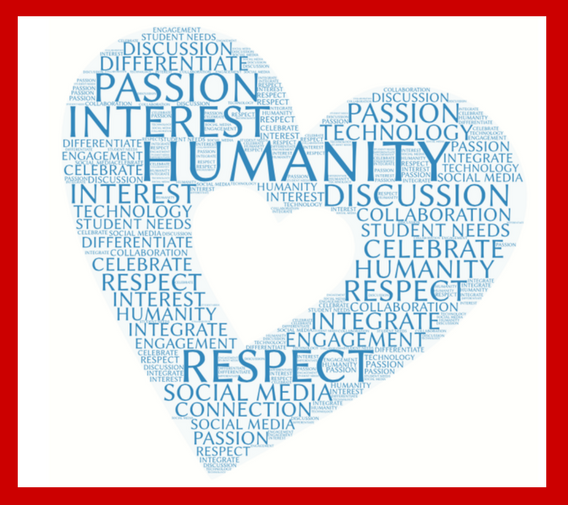by Mary Howard
May 4, 2017 will live in my mind as a very special day on #G2Great. On this day we welcomed remarkable Cornelius Minor and Courtney Kinney as we joined forces in a celebration of Brilliant Tapestries: Building Classrooms that Reflect the Lives of the Children Who Inhabit Them. This topic is near and dear to every educator who is committed to the very heart and soul of all we do – our children.
As I ponder the collective commitment of dedicated educators who live and breathe a vision for Brilliant Tapestries, I am drawn to Maya Angelou’s words:
We all should know that diversity makes for a rich tapestry, and we must understand that all the threads of the tapestry are equal in value no matter what their color.
The colorful threads of our Brilliant Tapestry symbolize our responsibility to be relentless advocates for every child who enters our classroom. Cornelius and Courtney are widely known as student advocacy leaders so we were hungry for their message of hope, evidenced when our conversation quickly trended on Twitter. For one inspirational hour, they became our teachers and we were willing students eager to soak in their wisdom. The energy was palpable as we formed a community of kindred advocacy spirits where our hearts and minds intersected in a joyful expedition of Brilliant Tapestries.
As I began the daunting task of reflecting on a conversation that surpassed the 1000 tweet storify limit, I was filled with the awesome responsibility afforded me to write this post. I wrestled with doubt in the days that followed the chat, wondering if I could possibly do such a critically important topic justice in a brief overview. But then I remembered that every journey begins with a single step and my hope for a post that would reflect first steps quieted my fears:
Our #G2Great educators reflect varying stages in their advocacy journey so for some this journey is in the early stages. #G2Great educators willingness to engage in this discussion represents their sense of advocacy urgency but this is also accompanied by equal parts of trepidation as we consider where to begin such expansive work. It is this breadth, however, that makes first steps even more important as those initial steps can offer an entry point for what follows.
Armed with renewed determination to take those first steps in the name of our Brilliant Tapestries, I turned back to Cornelius and Courtney for inspiration and revisited a multitude of tweets. Narrowing this passionate discussion into a brief overview was formidable and yet doing so was a fitting first step. Eight BIG ideas emerged from this awe-inspiring chat that I will forever hold dear. Although this feels inadequate to represent the scope of wisdom that loomed large in #G2Great, it is my hope that my noticings can offer a starting point for new or continuing journeys in classrooms across the country:

 BIG IDEA 1: Acknowledge that the journey is needed
BIG IDEA 1: Acknowledge that the journey is needed
We can no longer afford to turn a blind eye to the children who enter our classrooms and our responsibility to acknowledge and honor the identities each of them bring to the learning table. We must sharpen our professional lens to truly see the unique identities in front of us so that we can begin to ‘cultivate’ community. It is only when we can celebrate every colorful thread in each child’s life tapestry that we will embrace those identities with an open heart knowing that each distinct thread adds to the beauty of our Brilliant Tapestries.


BIG IDEA 2: Assume responsibility for change
Once we acknowledge the Brilliant Tapestries that inhabit our classrooms, we must then begin the change process that will allow us to truly create a culture of inclusivity that celebrates each child. To do this, we must begin by accepting our professional and ethical responsibility to children by recognizing that the structural systems in place are inadequate to make the significant changes we know are necessary. Once we do this we can begin to create new systems that will support our efforts to celebrate our Brilliant Tapestries.


BIG IDEA 3: Broaden your identity perspective
For too long, identity has been narrowly defined by color, gender, race or even financial status. We cannot truly see children as long as we focus on narrow descriptors of what we deem defines them. If we look closely, we will find that the identity they bring to our classrooms extends far beyond a label confined to a single descriptor. When we take time and effort to know children at a deeper level, varied identities begin to gloriously emerge both within and beyond our school walls as each one adds to our Brilliant Tapestry.

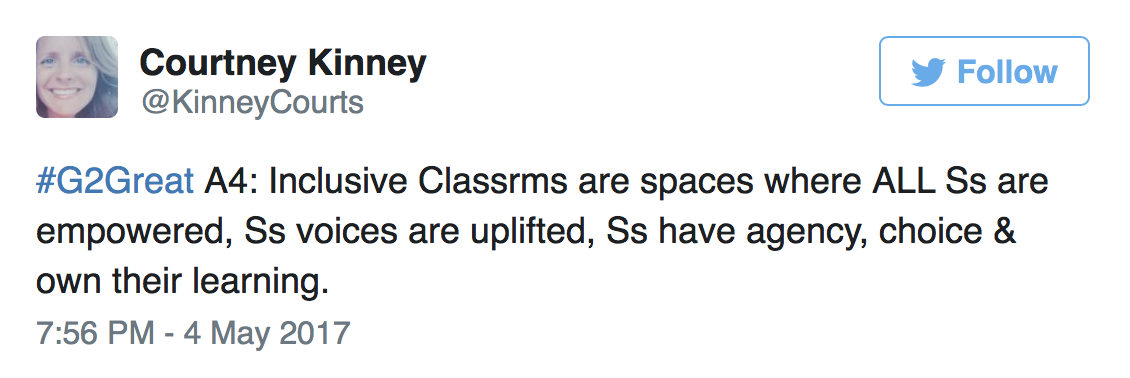
BIG IDEA 4: Lift students voices in joyful harmony
While these are important first steps, we will never truly create the inclusive classrooms our children deserve until we invite students into the conversation. Simply acknowledging that diversity exists is not enough. Inclusive assumes that we empower our students by lifting up their voices in ways that will give them choice, voice, and agency. And lifting up their voices means that we must truly hear them in order for our classrooms to change in any substantive way. Their voices are interwoven in our Brilliant Tapestries and bring it to life.


BIG IDEA 5: Widen your scope of reference
Embracing inclusive classrooms is certainly another important step in that journey but this means that we must move beyond our classroom doors. Embracing inclusivity is not limited by the life students live in our school but extends to the life they live beyond our schools. It is important that we don’t simply depend on formal structures to engage students and parents but find informal ways to demonstrate our role as ‘fierce and unapologetic advocates’ from both sides. Brilliant Tapestries reflect each aspect of our students’ lives.


BIG IDEA 6: Plant and nurture seeds of respect
We cannot create inclusive classrooms by simply giving lip service to the process of inclusivity. Rather we begin by planting the seeds that will create classrooms rooted in respect based on relationships we build with children in and beyond our school setting. Those relationship are not simply the ones that we build between teacher and students but extend to peers and community. These respectful relationships are reflected in our words and actions as we listen to and interact with students in ways that honor our Brilliant Tapestries.


BIG IDEA 7: Build a strong foundation first
This important work can seem so expansive that it’s tempting to want change to happen overnight. But time can be our greatest gift as we begin by creating classrooms where our children feel safe while acknowledging that we may well be their only safe haven. Creating a safe classroom culture takes time and in some cases may require undoing damage already done. We must ensure ‘safe’ is not just in our minds but also in the minds of the children who inhabit our classrooms. We strengthen the threads of Brilliant Tapestries by strengthening the foundation that supports those threads.
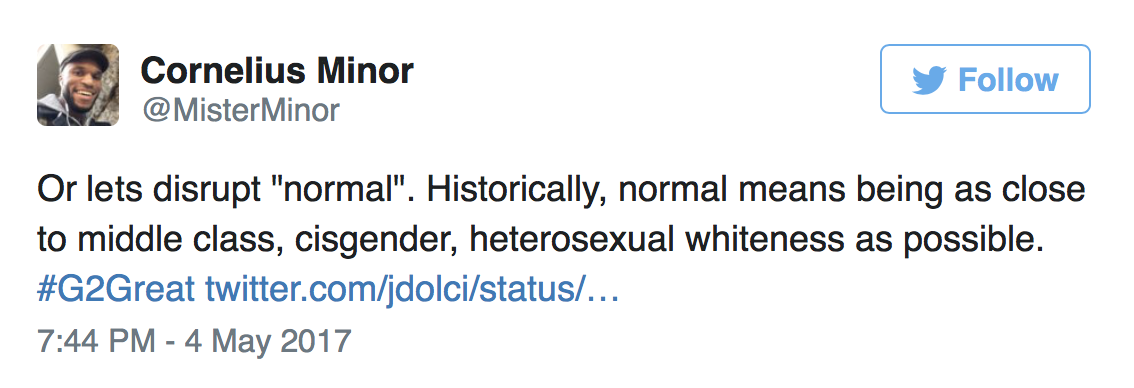
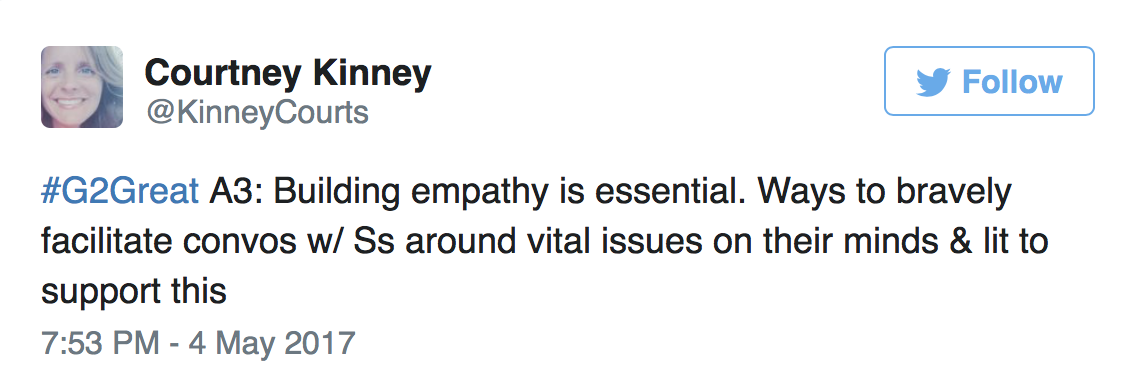
BIG IDEA 8: Courageously forge a new path
We have become complacent about how we define ‘normal’ and often based on our own sense of normal. Welcoming new students into our classrooms year after year requires us to see a new normal that is inclusive of every child in that classroom in that year. The educators participating in #G2Great received a hefty dose of brave, but we must initiate these same brave conversations in our schools. Our conversational journey was a supportive one – the same journey schools need as they redefine normal and create inclusive classroom. We will only truly celebrate our Brilliant Tapestries when this spirit can spreads across every classroom in every school.
As I close this post and reflect on the BIG ideas of our Brilliant Tapestries inspired by Cornelius and Courtney, I am further inspired by the words of Cornelius in a recent Heinemann Blog Post, Cornelius Minor on Being an Advocate for Your Students. In his eloquent words:

As each of us launches a personal and professional journey of choosing to do something to celebrate Beautiful Tapestries that inhabit our classroom, we can begin with honest introspection. Will we be proud of the choices we have made as educators? Will we be able to say with unwavering certainty that the something we did made our instructional world a better place and afforded our children a brighter future within and beyond our school walls? I am grateful to our advocacy leaders, Cornelius and Courtney, for initiating the conversation that will illuminate our way as we bravely forge our own path along a shared journey of commitment to fiercely advocate for our students.
So I end with a final question that will ultimately define the impact we have had in this world and in the lives of our children…
How can we step outside of the tapestry of our own lives and embrace the Brilliant Tapestries that connect us all?
——————————————————————————————–
Since this chat was about merging our collective voices, I would be remiss if I didn’t include other voices. Georgia Heard’s powerful words and Courtney’s eloquent response seems like a fitting way to merge our voices in an orchestra of shared commitment as we advocate that all kids have the right to “sing.”

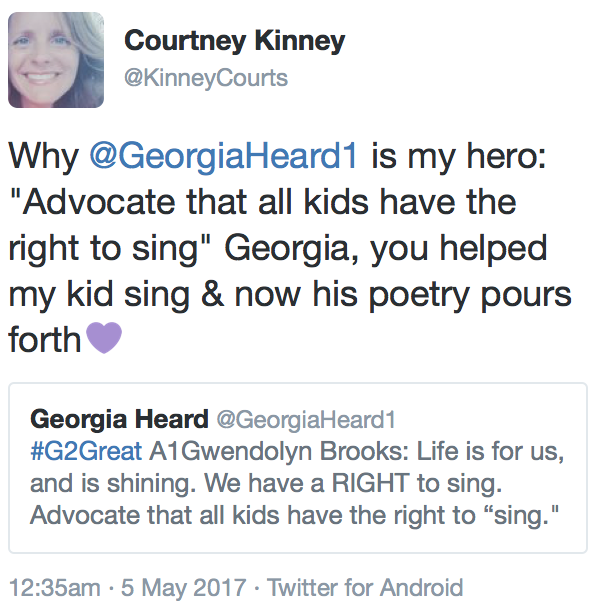
LINKS FOR CORNELIUS AND COURTNEY
WEBSITES
The Center for Racial Justice Innovation: https://www.raceforward.org/
National Women’s Law Center, Education Blogs: https://nwlc.org/blog/?term=1597#blog-search
Teaching Tolerance: teachingtolerance.org
Human Rights Campaign: hrc.org
Welcoming Schools: welcomingschools.org
We Need Diverse Books: weneeddiversebooks.org
GLSEN: glsen.org
Gender Spectrum: genderspectrum.org
CAST: http://www.cast.org
National PTA: PTA.org
EDUCOLOR: educolor.org
The Journey Project: thejourneyproject.us
Teachers College Reading and Writing Project: readingandwritingproject.org
Being Black at School: https://beingblackatschool.org/
Understood: https://www.understood.org/en
Lambda Literacy: http://www.lambdaliterary.org/
LGBT Community Centers: http://www.lgbtcenters.org/
Transyouth Family Allies: http://www.imatyfa.org/
PFLAG: https://www.pflag.org/
Stonewall National Education Project: https://www.stonewall-museum.org/projects/national-education-project/
BLOGS
https://rusulalrubail.com/
http://www.natebowling.com/
http://thejosevilson.com/
crawlingoutoftheclassroom.wordpress.com
pernillesripp.com
Readingwhilewhite.blogspot.com
http://rafranzdavis.com/
heinemann.com
Cornelius Minor:
Cornelius’ Blog Post:
http://www.heinemann.com/blog/why-blacklivesmatter-in-your-classroom-too/
PODCASTS
Cornelius Minor Podcast 1: Being an Advocate for Your Students
http://www.heinemann.com/blog/the-heinemann-podcast-cornelius-minor-on-being-an-advocate-for-your-students/
Cornelius Minor podcast 2: Identifying Won’t Learn and Can’t Learn
http://www.heinemann.com/blog/the-heinemann-podcast-cornelius-minor-2/
Cornelius Minor’s Credo: NCTE16 Don Graves Breakfast Podcast
http://www.heinemann.com/blog/ncte16-don-graves-breakfast-podcast/
THE JOURNEY PROJECT BLOG
**Mary, I really want to center the posts from Kid Writers first—they are the most important voices.
KID WRITERS:
An Open Letter to Adults from a Transgender Child
http://thejourneyproject.us/2017/02/24/open-letter-adult-trans-child/
Reflection on Friendship
http://thejourneyproject.us/2016/12/06/reflection-on-friendship/
A Child’s Voice
http://thejourneyproject.us/2016/11/06/uplifting-the-childs-voice-a-poetic-journey/
Loneliness: A Poem
https://thejourneyproject.us/2017/05/03/loneliness/
COURTNEY KINNEY REFLECTIONS
Three Little Words
https://thejourneyproject.us/2017/05/02/three-little-words/
He. Came. Alive. Today.
http://thejourneyproject.us/2017/04/29/he-came-alive-today/
I Missed It, But Never Again
http://thejourneyproject.us/2017/04/06/i-missed-it-but-never-again/
Legacy
http://thejourneyproject.us/2017/03/16/legacy/
Still Waters Run Deep: A Letter to My Trans Child
https://thejourneyproject.us/2017/05/05/still-waters-run-deep/
